The following list highlights some of the best places to visiting in China. So if you are in China, I recommend visiting the following:
- Hongcun Ancient Village, Anhui, China
- Yellow Mountains, Anhui, China
- Mount Wuyi, Fujian, China
- West Lake, Hangzhou, China
- Brahma Palace, Chengqiang, Jiangsu, China
- Sun Yat-sen Mausoleum, Jiangsu, China
- Mount Lu, Jiangxi, China
- Trestle Bridge, Qingdao, China
- Yuyuan Garden, Shanghai, China
- 798 Art District, Beijing, China
- Beijing Summer Palace, Beijing, China
- Forbidden City, Beijing, China
- Old Summer Palace, Beijing, China
- Silk Market, Beijing, China
- Temple of Heaven, Beijing, China
- The Great Wall of China, Beijing, China
- The Silk Route, Beijing to Samarkand, China
- Chengde Mountain Resort, Hebei, China
- Saint Sophia Cathedral, Heilongjiang, China
- Xi’an City Wall, Chengqiang, China
- Mogao Caves, Gansu, China
- Terracotta Warriors, Lintong, China
- Qinghai Lake, Qinghai, ChinaQinghai-Lake-Qinghai
- Hua Shan Mountain, Shaanxi, China
- Heavenly Lake of Tianshan, Xinjiang, China
- Nalati Grasslands, Xinyuan, China
- Yulong River, Guangxi Zhuang, China
- Li River, Guilin, China
- Guanyin Statue, Hainan, China
- Yalong Bay, Hainan, China
- Longmen Grottoes, Henan, China
- Shennongjia, Hubei, China
- Fenghuang, Hunan, China
- Longtan Valley, Hunan, China
- Tianmen Mountain, Hunan, China
- Fortress Towers, Kaiping, China
- Longji Rice Terraces, Longsheng, China
- Wolong National Park, Chengdu, China
- Wuhou Temple, Chengdu, China
- Three Pagodas, Dali, China
- Huangguoshu Waterfall, Guizhou, China
- Nuorilang Waterfall, Jiuzhaigou, China
- Bifengxia Panda Base, Sichuan, China
- Chengdu Panda Center, Sichuan, China
- Hailuogou Glacier Park, Sichuan, China
- Jiuzhaigou National Park, Sichuan, China
- Leshan Buddha, Sichuan, China
- Mount Emei, Sichuan, China
- Jade Dragon Snow Mountain, Yunnan, China
- Lugu Lake, Yunnan, China
- Pudacuo National Park, Yunnan, China
- Tiger Leaping Gorge, Yunnan, China
The Best Places in East China (Huadong)
1. Hongcun Ancient Village, Anhui
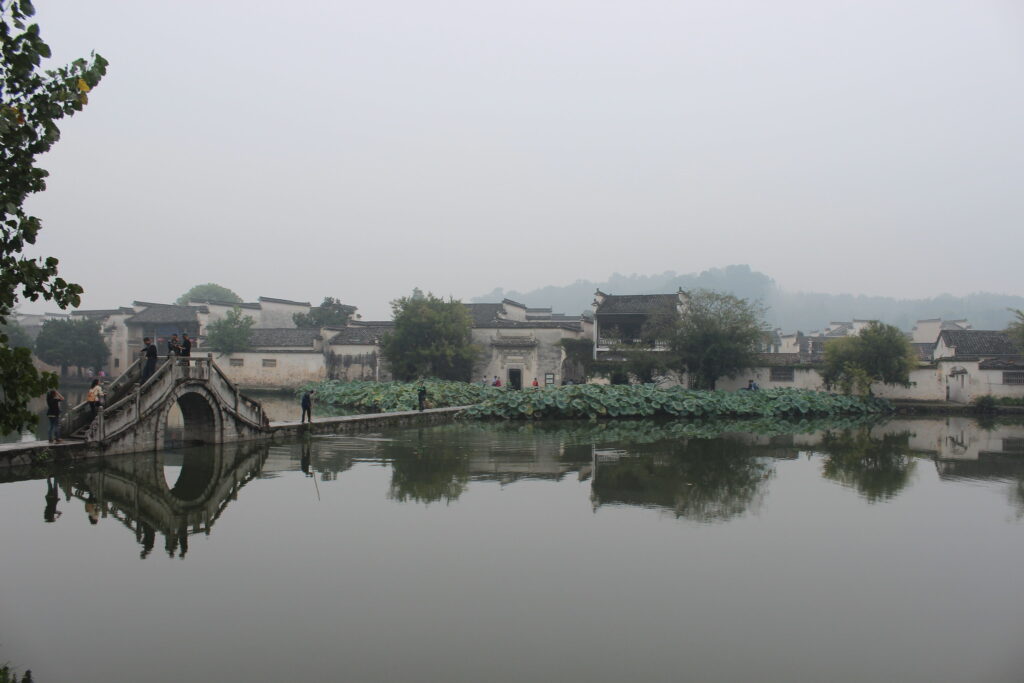
It is a picturesque village with a history of about 900 years. During the Ming and Qing dynasties, economic prosperity led to the construction of many impressive houses. Today there are 138 well-preserved Ming and Qing residences standing in the village. Hongcun is probably the best known Huizhou village today. Any visit to this ancient town should include South Lake, South Lake Academy, Moon Pond and Chengzhi Hall.
2. Yellow Mountains, Anhui
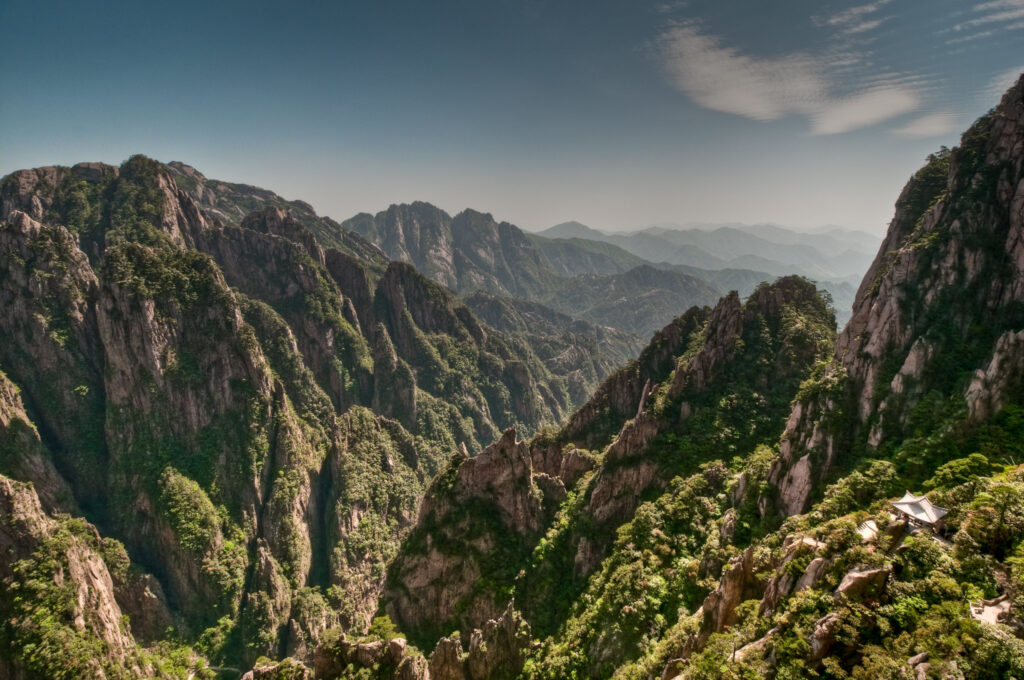
This chain of beautiful mountains is a true sanctuary of nature, as you can see how its granite peaks form a spectacle that will leave you breathless to see how often the clouds descend to cover the top of mountains that reach 1,800 metres high. In the lower part you can see a magnificent image of its deep forests where incredible specimens of vegetation are born, such as the Huanghan pine, a tree with thick bark and with a particular ability to adapt to the rocks and slopes of the mountains. The Yellow Mountains of China were declared a UNESCO World Heritage Site in 1990.
3. Mount Wuyi, Fujian
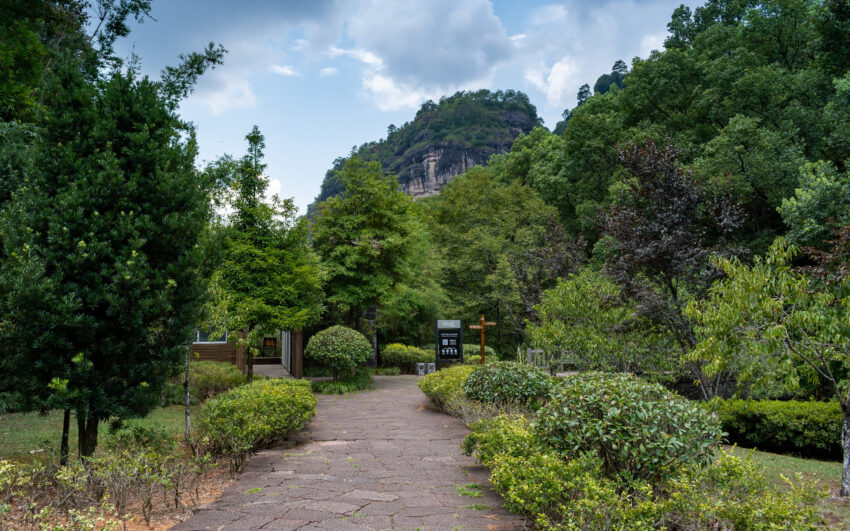
Wuyi is a very relevant territory at a natural level: it has a humid subtropical forest thanks to the fact that the mountains retain the northern winds and create a warm climate. The fauna has a lot of Chinese endemism and three species that are only found in these mountains: a small bird, a frog and a snake. Larger, but endangered, are the tiger, leopard, clouded panther or the impressive Chinese giant salamander. In addition, Wuyi is a paradise for entomologists for its nearly 5,000 species of invertebrates, including butterflies. It is not possible to enter the mountains with your own transport, so it is ideal to move by bus between the entrances. It is worth reserving two days for this area because of the numerous treks available.
4. West Lake, Hangzhou

West Lake has been declared a World Heritage Site. Throughout history it has served as inspiration for many artists and today its landscapes are the protagonists of numerous photographic captures. The waters of the lake cover an area of more than seven square kilometres, making it a pleasure to take boat rides while breathing in the tranquillity and peace of the surroundings. Its shores are carpeted with colourful and cheerful gardens. But water and gardens are not the only elements that stand out in this small natural paradise in the city of Hangzhou. The West Lake is dotted with temples, bridges, pagodas and four islands, three of them artificial.
5. Brahma Palace, Chengqiang, Jiangsu
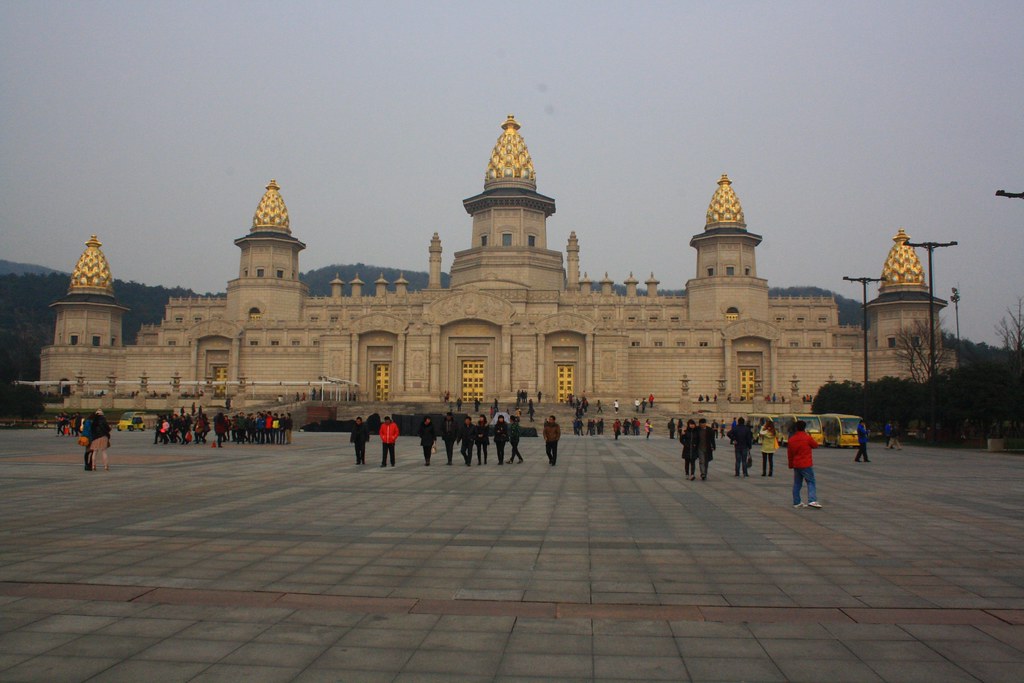
The Brahma Palace was built 88 metres high at the foot of the “Little Lingshan Mountain ”, near the Taihu Lake and the Lingshan Giant Buddha. This majestic work was built in 2008 for the Second World Forum of Buddhism. Inside, it has a luxurious theme park with gold ornaments and lots of glamour, all surrounded by mountains and rivers.
6. Sun Yat-sen Mausoleum, Jiangsu
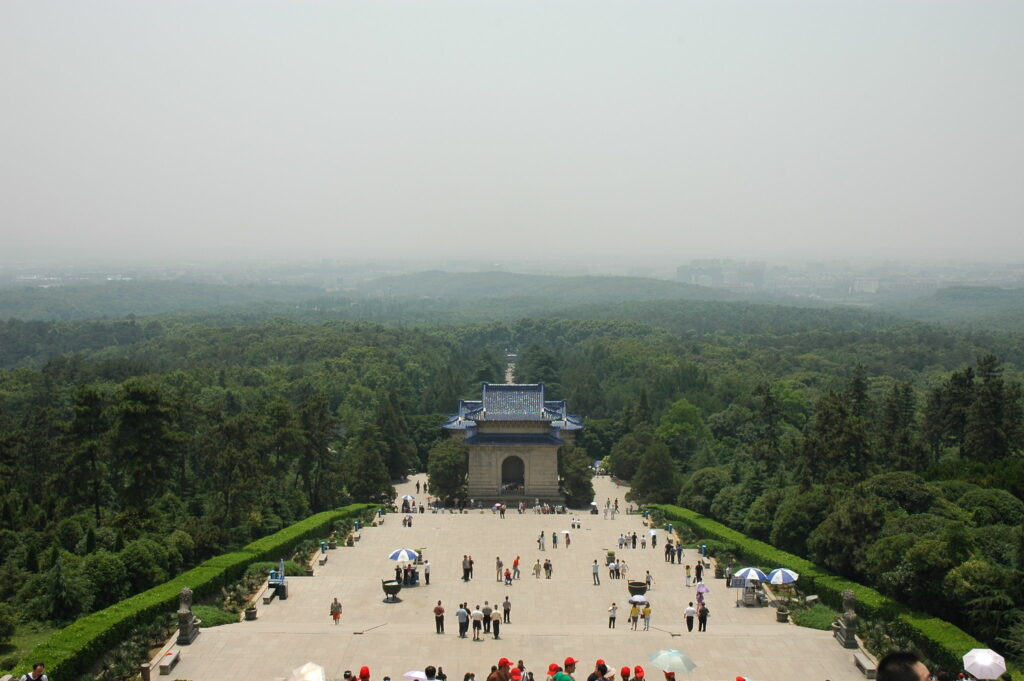
The mausoleum covers an area of 80,000 square metres and is shaped like a bell. This shape symbolises how Sun Yat-sen awakened the Chinese consciousness. The monument consists of three marble arches overlooking a long tree-lined street. On the arch is an inscription written by Sun himself: “The nation is the nation of the people and everyone should serve the nation selflessly”. The entrance to the mausoleum is via a flight of 392 steps.
7. Mount Lu, Jiangxi
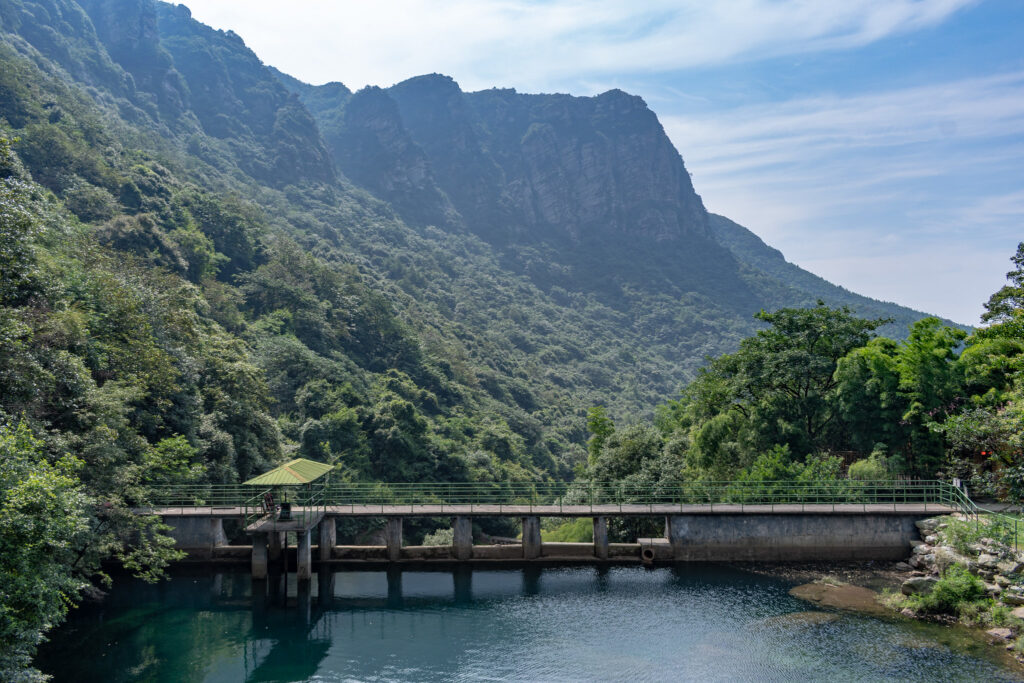
This World Heritage Site by Unesco since 1996 is considered an emblem of the spirituality and culture of China, to which more than 1,500 painters and poets from periods of both ancient and modern China have come to find inspiration. One of these artists is Li Bai, a member of the Tang Dynasty and Xu Zhimo, who in the 1920s travelled to this peaceful mountain and used it as a source of illumination for his works.
8. Trestle Bridge, Qingdao
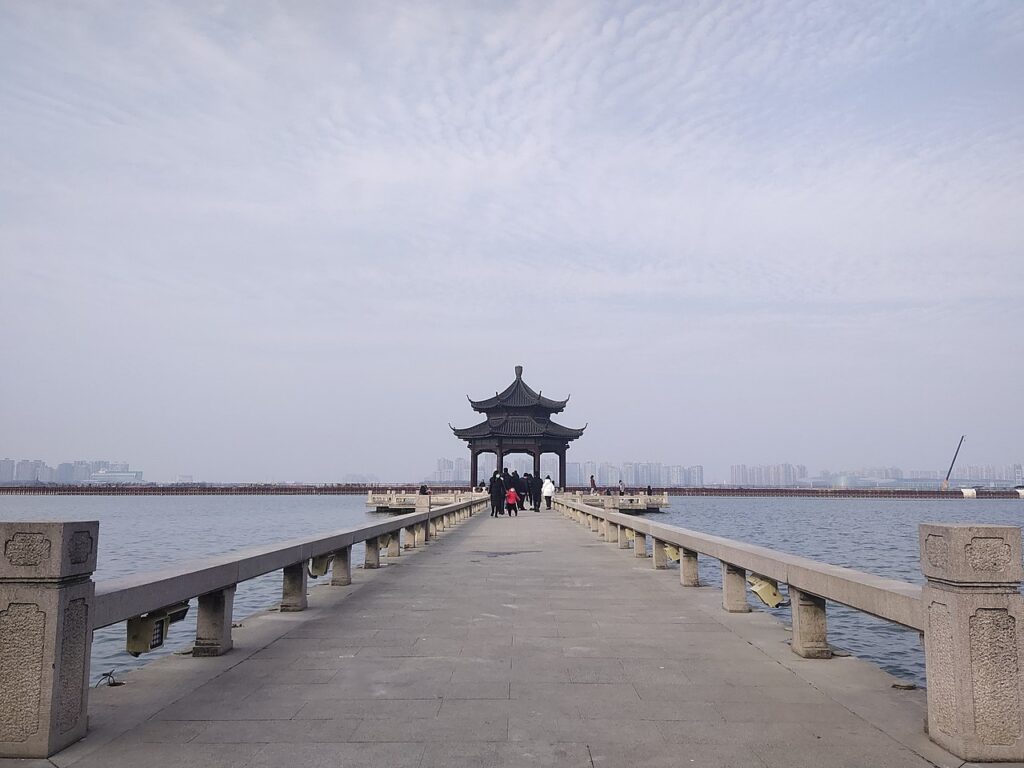
The Trestle Bridge, one of China’s tourist attractions as old as the city of Qingdao, where it was built, has stood over the Yellow Sea since 1892. The work was erected to honour Li Hongzhan, an important statesman of the Qing dynasty. Now it is an emblem of the city of 440 metres long. At one of its ends was built the Huilange pagoda, where exhibitions and cultural presentations are held throughout the year.
9. Yuyuan Garden, Shanghai
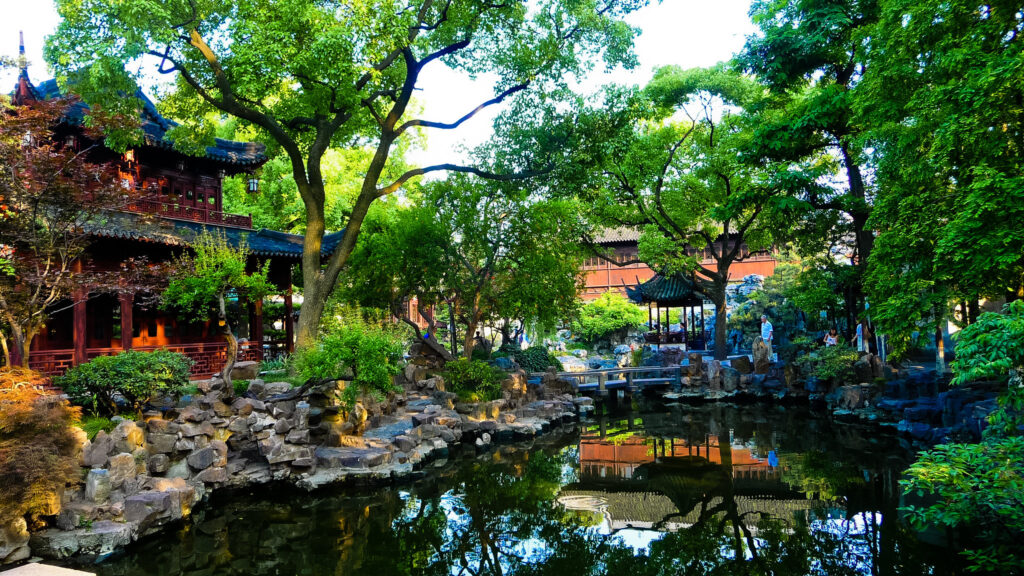
It is one of the most famous gardens in China built as a symbol of love from Pan Yunduan, governor of Sichuan, to his elderly parents. It is north of Shanghai, near the ancient wall. One of its most photographed attractions is the large jade stone in the centre of the garden, which exceeds 3 metres. It is one of the best and most beautiful tourist sites in China.
The Best Places in North China (Huabei)
10. 798 Art District, Beijing
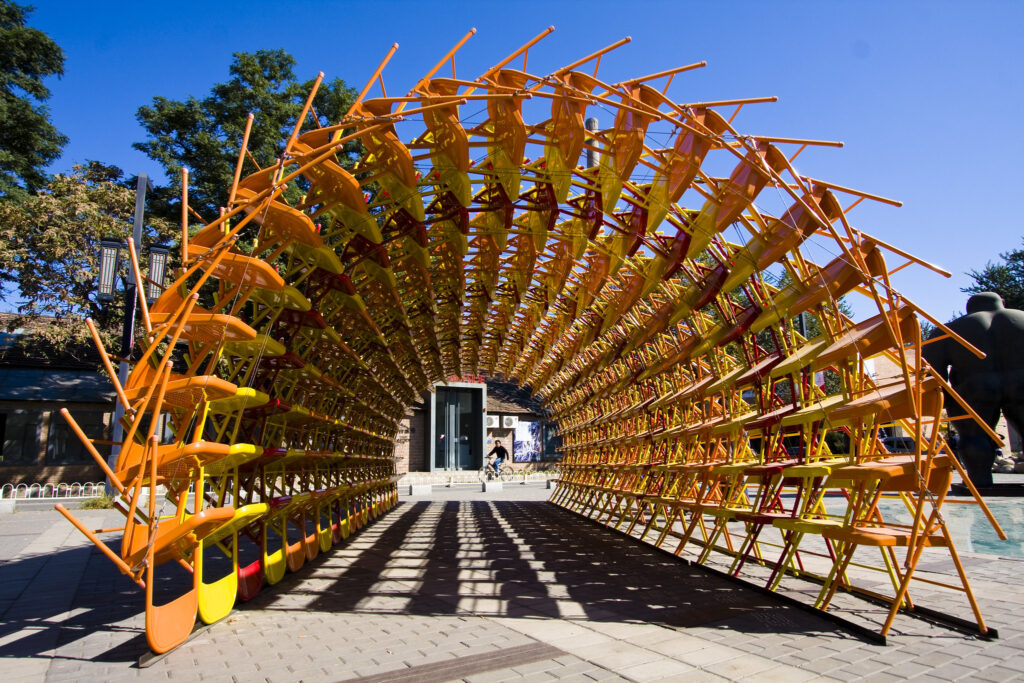
District 798 was a former industrial zone created in the 1950s that by the early 1990s had almost been completely abandoned. From 1995 onwards, many artists and artistic associations, escaping from the urban pressure of the city centre, began to settle here because of the low prices and the availability of large spaces. Little by little the area became more and more popular, until it finally became a tourist attraction. Nowadays District 798 has become so popular that it has forced artists to move their studios to a cheaper location, leaving at most one gallery to sell their work. Other than that, the district has become filled with cool bars, snob housing and souvenir stores.
11. Beijing Summer Palace, Beijing
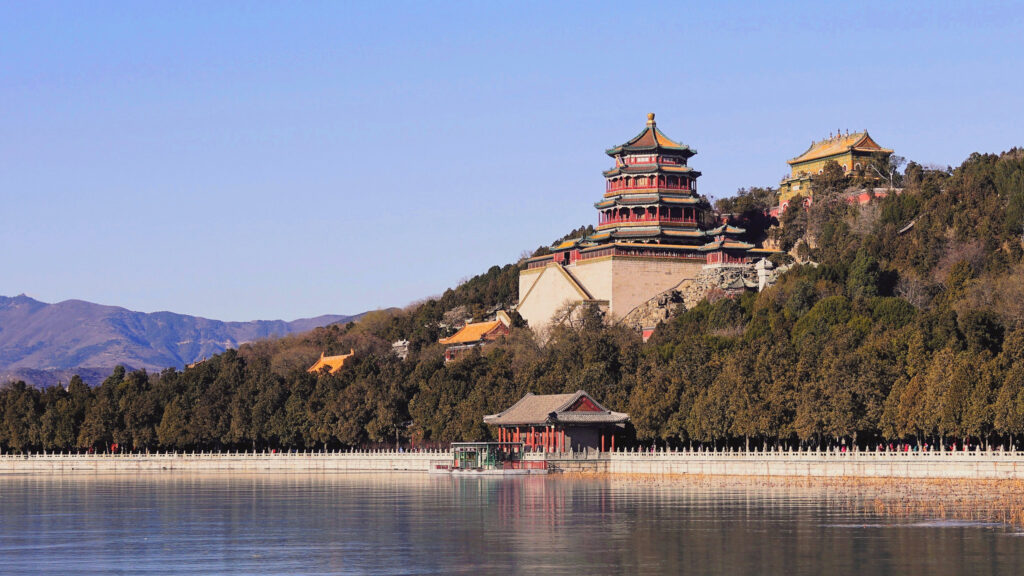
Palace built on the initiative of Emperor Qianlong in 1750. It is on the shores of Kunming Lake with a large corridor, roofed space of 750 metres and decorated with more than 14 thousand paintings. The Summer Palace has as many landscapes of lakes and hills as gardens. The different blocks of apartments have different styles and mutual relationships. At the same time, they take advantage of the West Mountain and the surrounding Yuquan Mountain as a backdrop, where artificial constructions and natural landscapes are combined, which is described as an excellent example of the art of gardening.
12. Forbidden City, Beijing
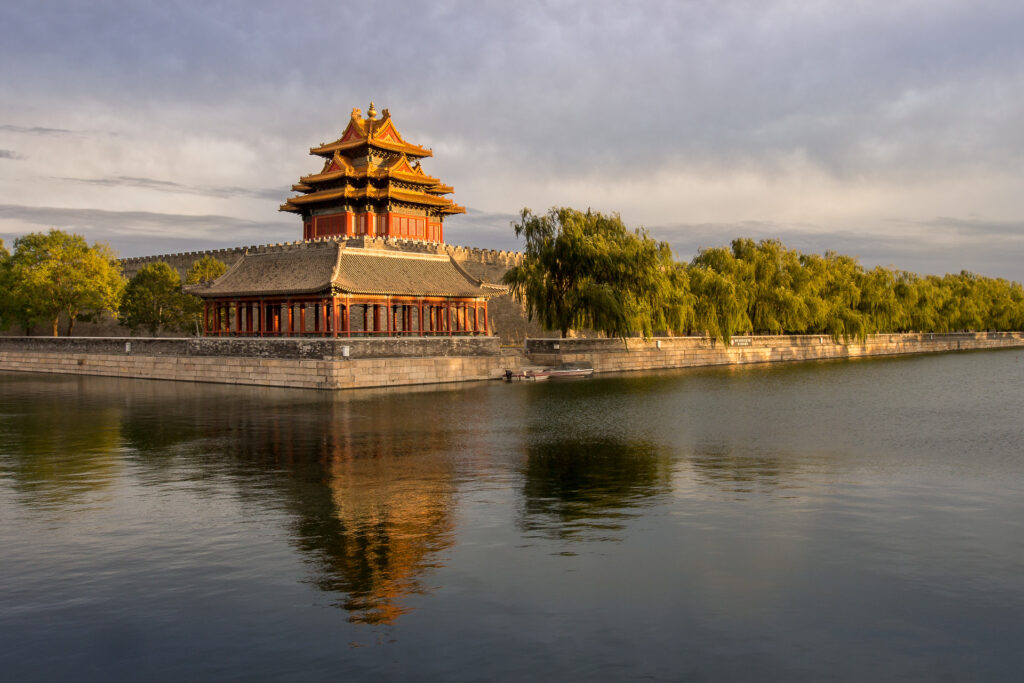
The Forbidden City is one of China’s tourist sites that was once a royal palace that housed 24 emperors. An almost sacred place not accessible to the public. The palace is a sample of the extravagance with which the constructions were made in ancient times. Each of the more than 8,000 rooms with gold-painted ceilings has a special and elegant design, with walls painted in red and yellow colours. Today it is a Unesco World Cultural Heritage Site and is colloquially known by the Chinese as “The Palace Museum”, one that holds treasures and historical and cultural relics of the country.
13. Old Summer Palace, Beijing
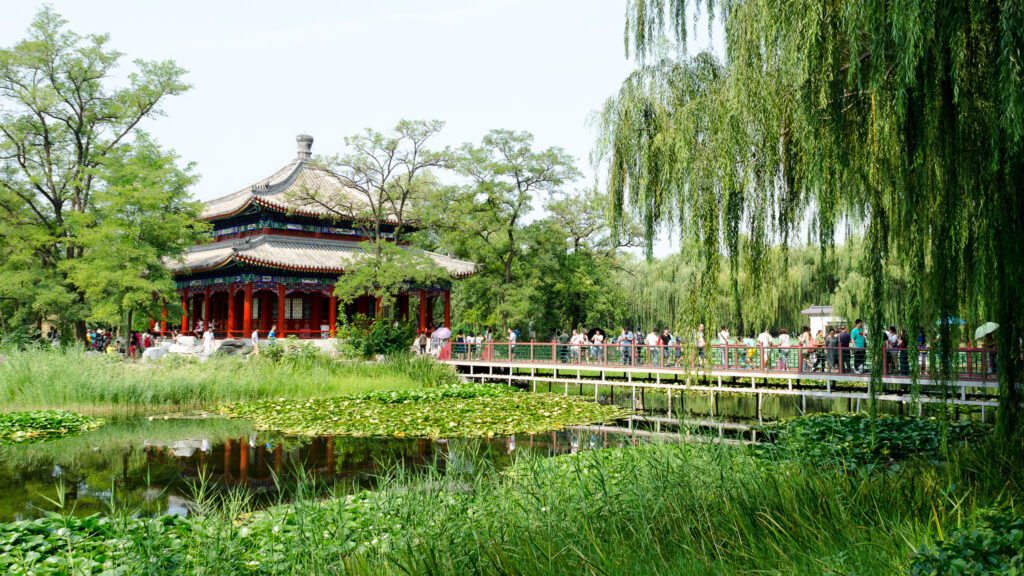
The site of the Old Summer Palace, the size of New York’s Central Park, is known in Chinese as Yuanming Yuan and dates back to the 12th century. Today, the Old Summer Palace contains only the ruins of a large palace and a large garden with a lake, trees and paths. Boat rentals are also available on the large central lake. The Old Summer Palace is popular with Chinese tourists because of its history, but foreign tourists do not have much to see and do here. If you want to see the traditional Imperial Palace and park, the Summer Palace is the right choice.
14. Silk Market, Beijing
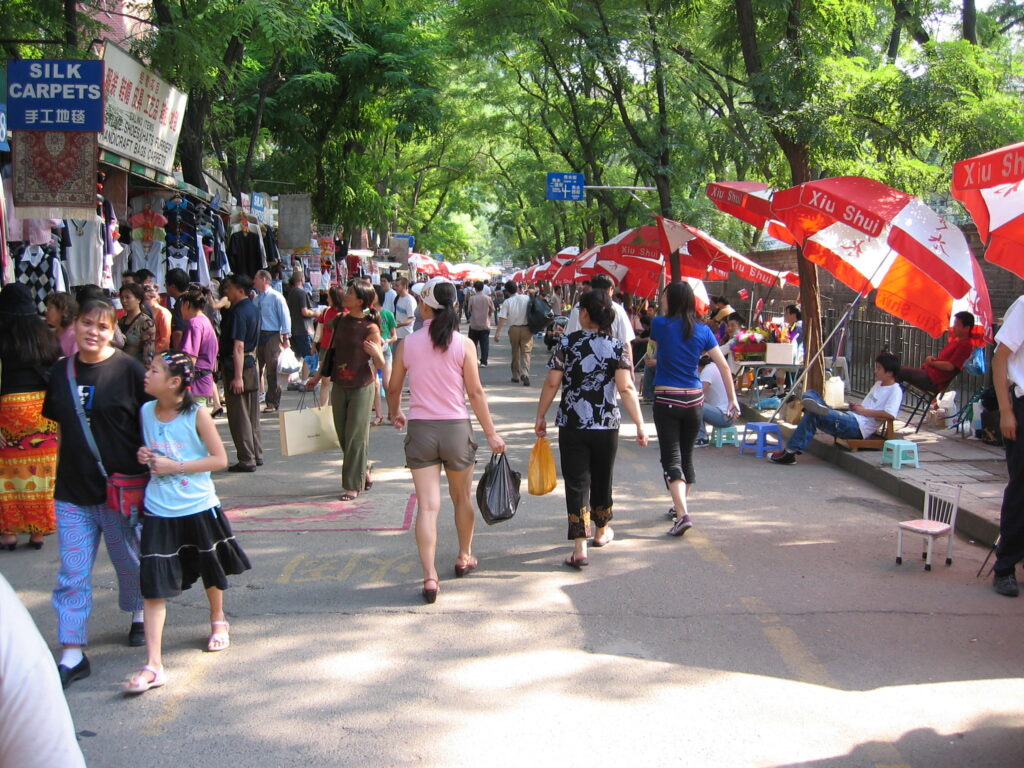
It is actually known as the Silk Street. When you arrive at the Beijing Silk Market, at first you will have the impression that you are in a typical shopping mall full of stores. But you will quickly see that on each floor are crowded commercial stalls offering a multitude of products, with a total of up to 1,700 in the entire building. On each of the floors are grouped stalls of similar products, such as those offering watches and glasses, or clothing of all kinds, handbags, sportswear or suitcases.
15. Temple of Heaven, Beijing
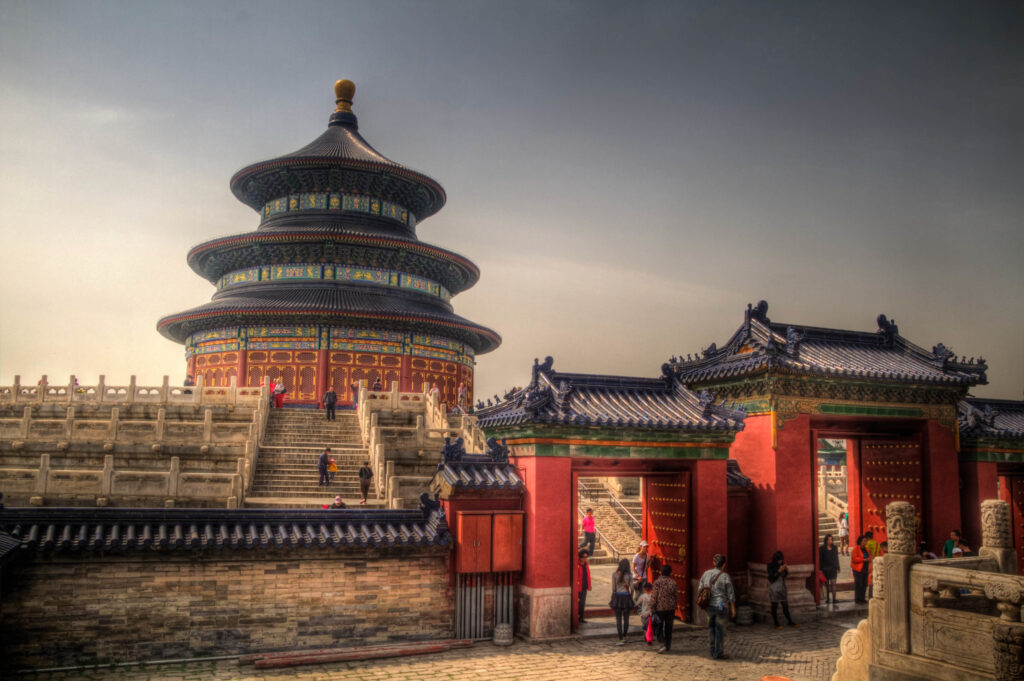
The Temple of Heaven is the largest temple of its kind in the whole country, which makes it one of the most popular tourist sites in China. It is also considered the most mystical place in the entire Asian nation. The shrine is in the centre of Tiantan Gongyuan Square, towards the southern region of Beijing. To the Temple of Rogatives, inside the enclosure, the faithful come to pray and ask for a most good year for themselves and their families.
16. The Great Wall of China, Beijing
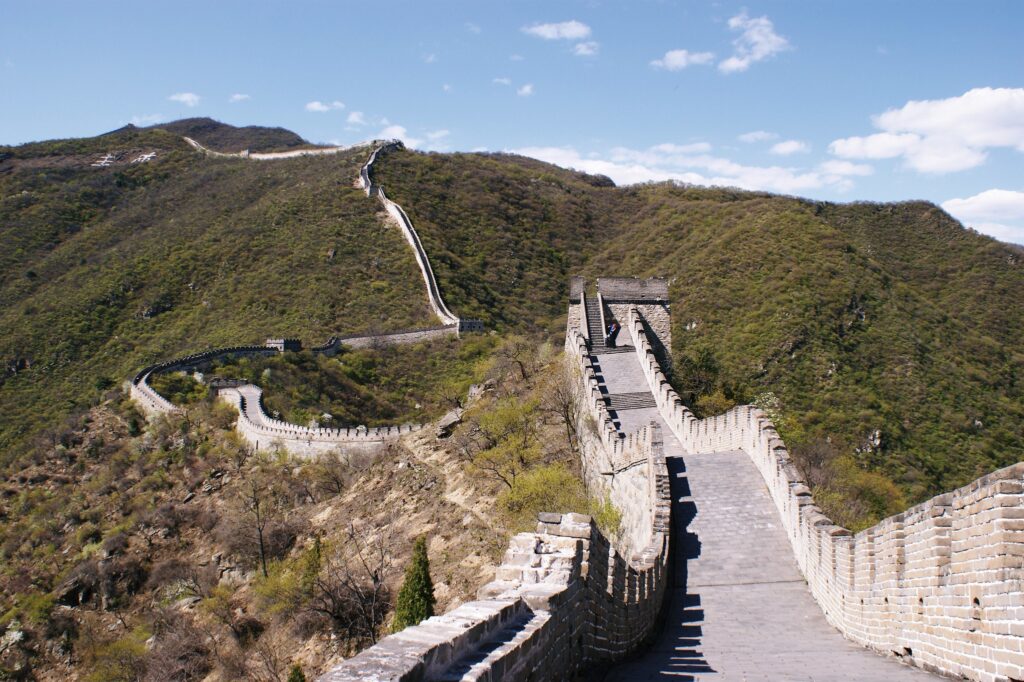
This feat of ancient world architecture, one of the New Seven Wonders of the Modern World and a World Heritage Site, was erected as a defensive wall against foreign offensives that wanted to invade Chinese territory. Its builders undertook the work along kilometres of rugged terrain, with steep mountainous areas and adverse climates. The Great Wall runs from the western border of China to its coast, with landscapes of unparalleled and real beauty that serve as tourist attractions.
17. The Silk Route, Beijing to Samarkand
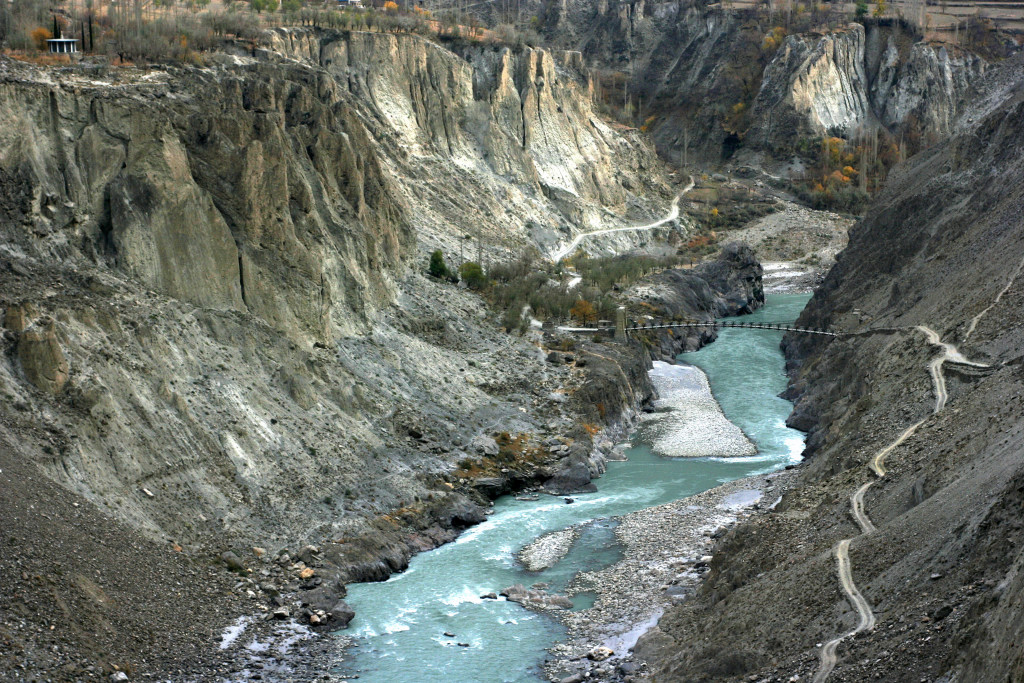
The Silk Road is one of the most famous routes in history, the great connector of the known world for centuries. It was a network of roads, of trade routes rather than a single, extensive route that eventually ended up linking Asia, the Middle East and Europe with branches in the Indian subcontinent and Russia. Although it was called the Silk Road, not only silk was traded, but also spices, sugar, ceramics, tea, salt, ivory, furs and jewellery, for example. Some of the most interesting Silk Road itineraries start in Beijing and end in Tashkent, Uzbekistan. Others cross the breadth of China and pass through Kyrgyzstan so they concentrate on Central Asia, for many the most interesting and curious section, with many cultural contrasts.
18. Chengde Mountain Resort, Hebei
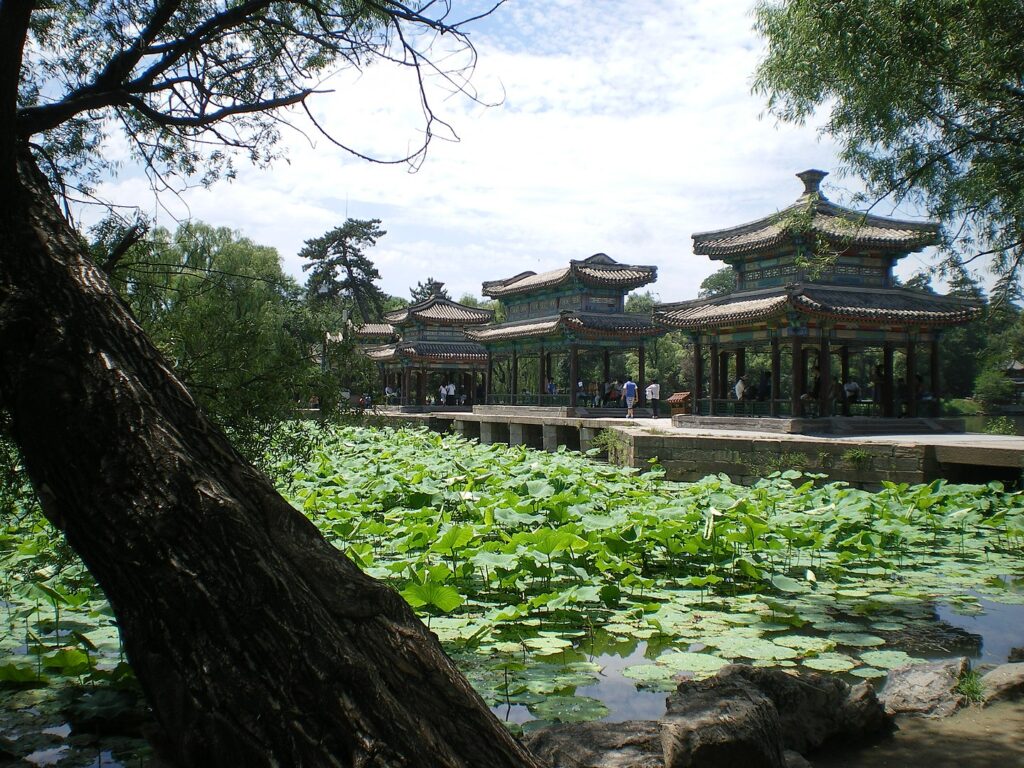
It is a vacation and resting place built during the Qing dynasty, now a UNESCO World Heritage Site. It has beautiful and delicate gardens and a 70-metre pagoda. In addition, majestic grounds of large meadows, high mountains and quiet valleys, make it easy to understand why it was chosen for vacation and relaxation.
The Best Places in Northeast China (Dongbei)
19. Saint Sophia Cathedral, Heilongjiang
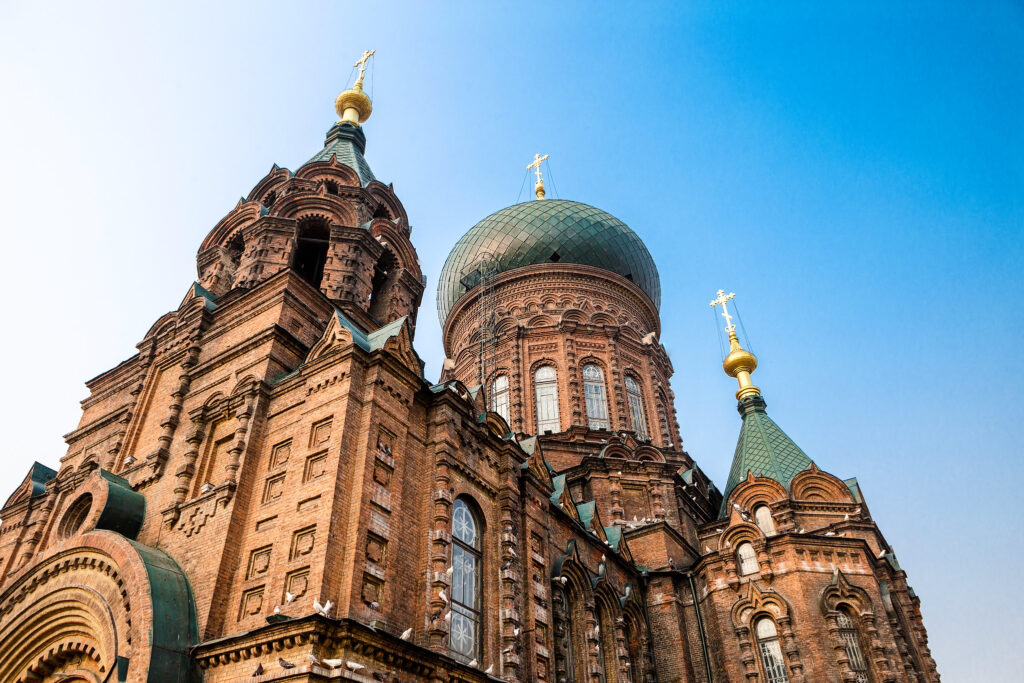
It is an orthodox church in the city of Harbin, the largest in the eastern and southeastern part of the Asian continent. This neo-Byzantine style temple was built with 721 square metres, by Russians expelled from their country who settled in the region. It was built at the beginning of the 20th century so that at the end of the war between Russia and Japan, the Orthodox community would have a place of worship and prayer. The Communist Party used it for 20 years as a warehouse. Now it is a museum where the architecture, art and heritage of the city are exhibited.
The Best Places in Northwest China (Xibei)
20. Xi’an City Wall, Chengqiang

Originally built in the 14th century by the first emperor of the Ming dynasty, the great rectangular wall of Xi’an is an impressive and unmissable stop on any Xi’an itinerary. It is considered the best-preserved urban wall in China and is a UNESCO World Heritage Site. With Xi’an’s ancient centre inside and modern buildings lining its exterior, the Xi’an City Wall is a great place to stroll or cycle and soak in the historic atmosphere of this ancient city.
21. Mogao Caves, Gansu
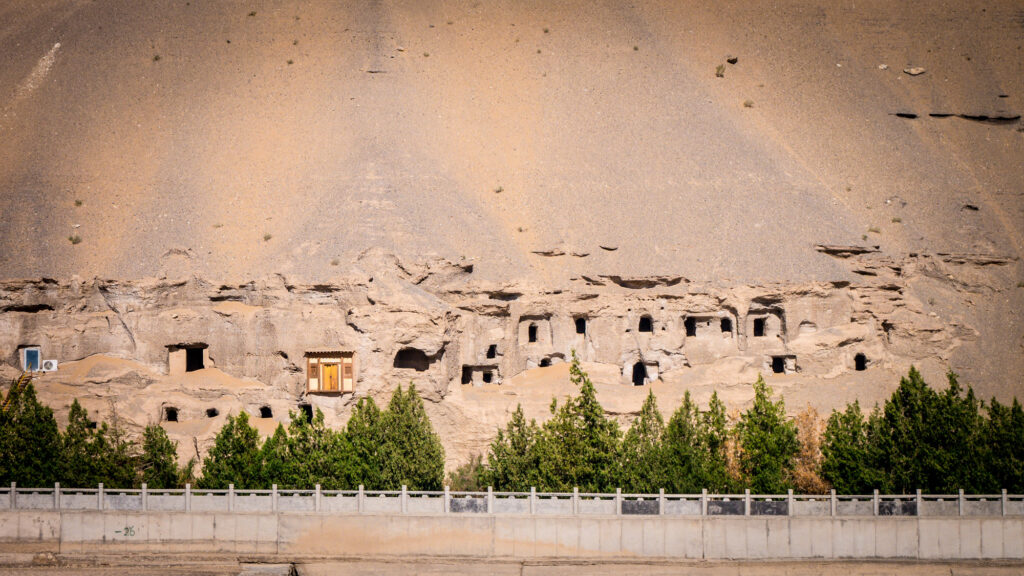
The Mogao Caves comprise more than 400 subway temples of ancient murals and literary scrolls in Gansu Province. The walls of the temples are covered with hundreds of murals dedicated to Buddhism, which are believed to have been built by the Buddhist, Lo-tsun, after he had a vision of thousands of Buddhas shining like flares from a cliff.
22. Terracotta Warriors, Lintong
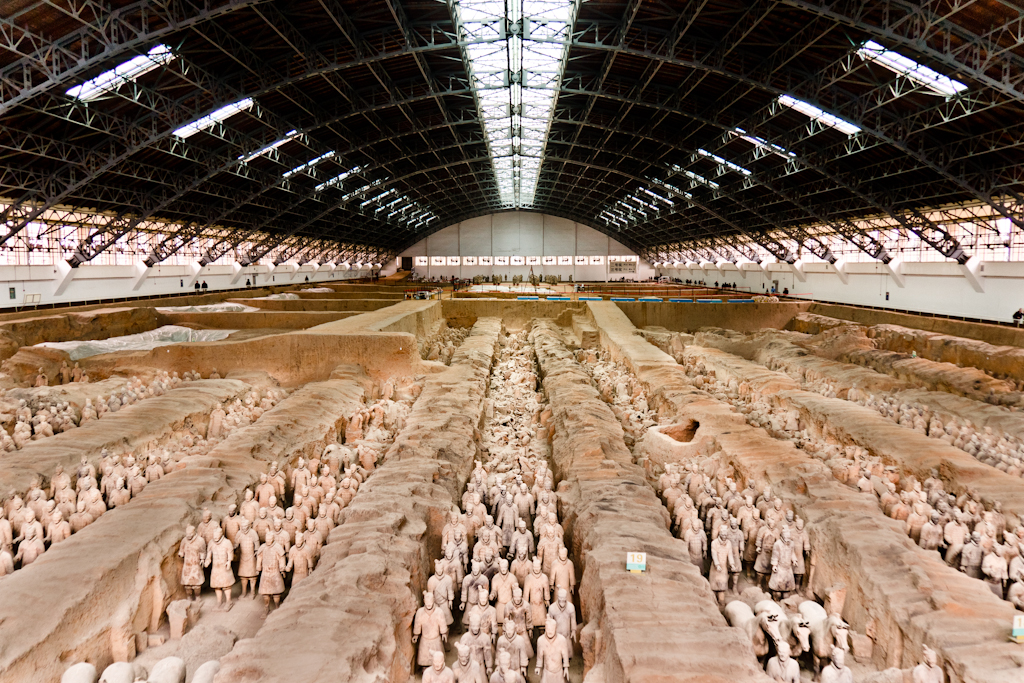
The carved figures are of average size for the time and were built by the emperor, Qin Shin Huang, in the Qing dynasty, to ensure the eternal fidelity and commitment of his soldiers. In addition to being declared the Eighth Wonder of the World, the Terracotta Warriors were also declared a World Cultural Heritage Site in 1987 and are considered one of the most important archaeological sites on the planet. The thousands of these figures are in Shanxi province, very close to Xi’an, which can be reached by bus.
23. Qinghai Lake, Qinghai
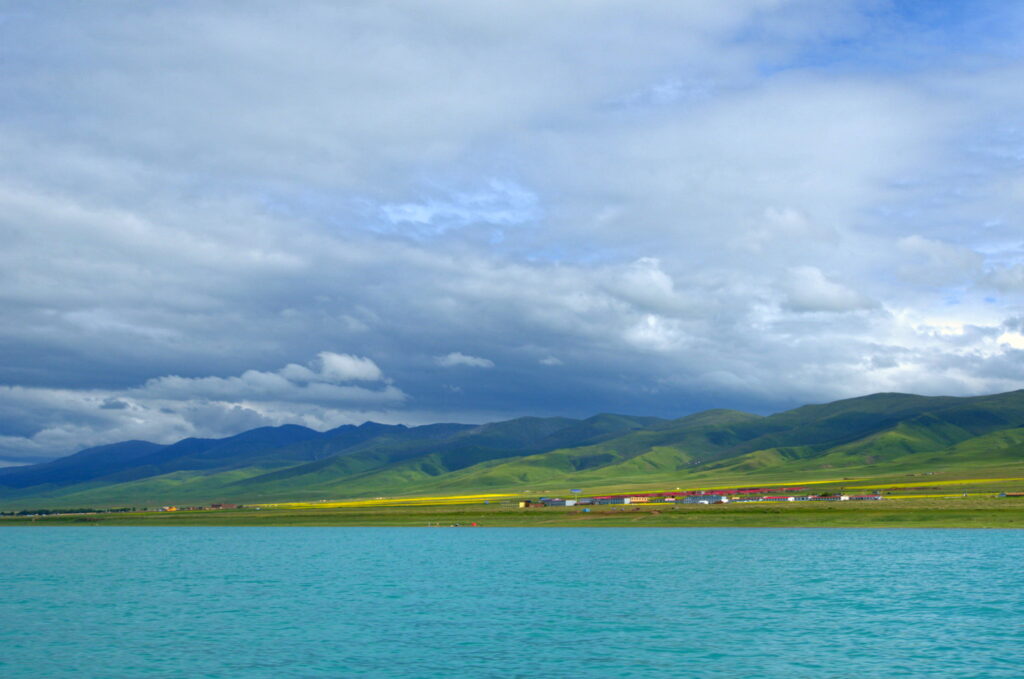
Qinghai is the largest salt lake in China. It is 3,205 metres above sea level in the province of Qinghai, a height that does not prevent it from being one of the most touristic places in the country. Once a year and during June and July, groups of people arrive who have made the journey pedalling their bicycles. Every summer the Qinghai National Lake Tour Cycling Race is held.
24. Hua Shan Mountain, Shaanxi
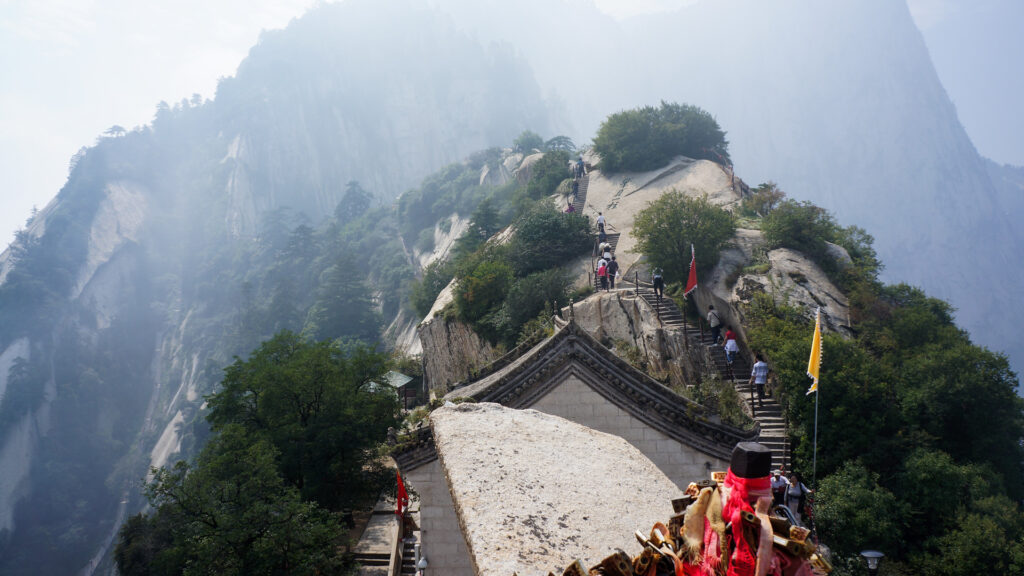
Hua-Shan is one of the five sacred mountains of Taoism in China. To reach it, thousands of pilgrims must travel one of the most dangerous paths in the world. The most daring who reach the top will find the Taoist temple and incredible views. It is an ideal mountain for people who practise extreme sports such as mountaineering or parkour, as well as for taking photographs and recording videos.
25. Heavenly Lake of Tianshan, Xinjiang
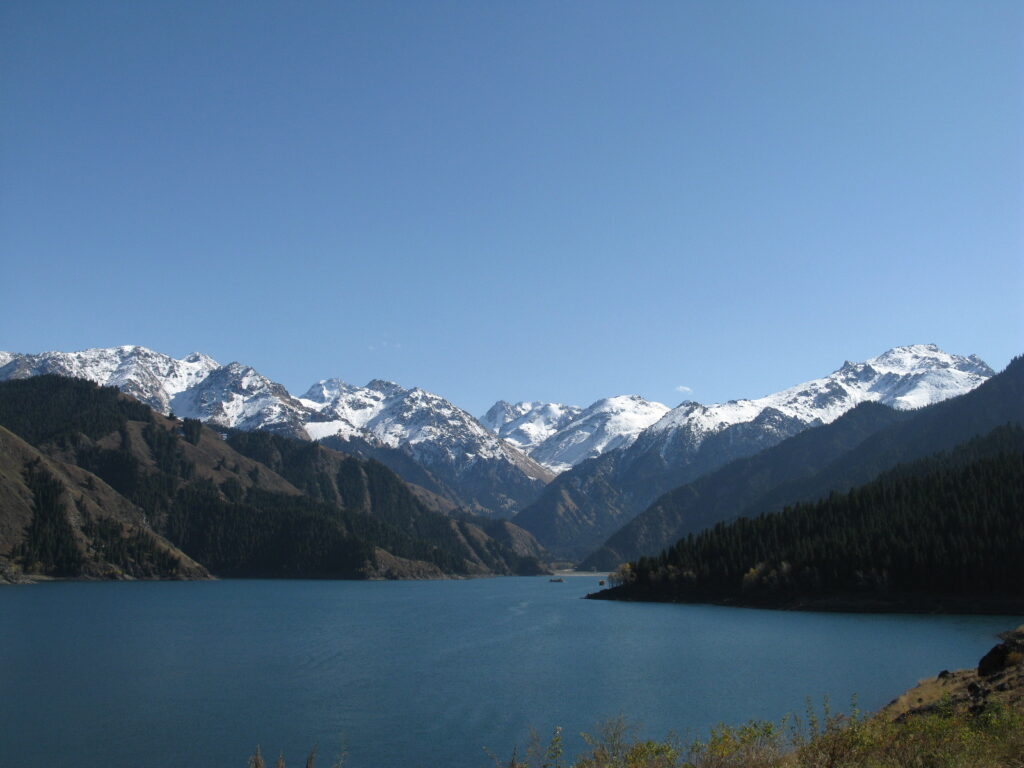
Tianchi Lake, which literally means “heavenly lake” in Chinese, is located about 100 kilometres east of the city of Urumqi in northwest China’s Xinjiang Uygur Autonomous Region. Known for its breathtaking views, Tianchi Lake has been classified as a highest level scenic area by the China National Tourism Administration. It is best to go in the late spring, summer and autumn when it is not freezing. Even in the summers, however, there could be frost in the early mornings.
26. Nalati Grasslands, Xinyuan
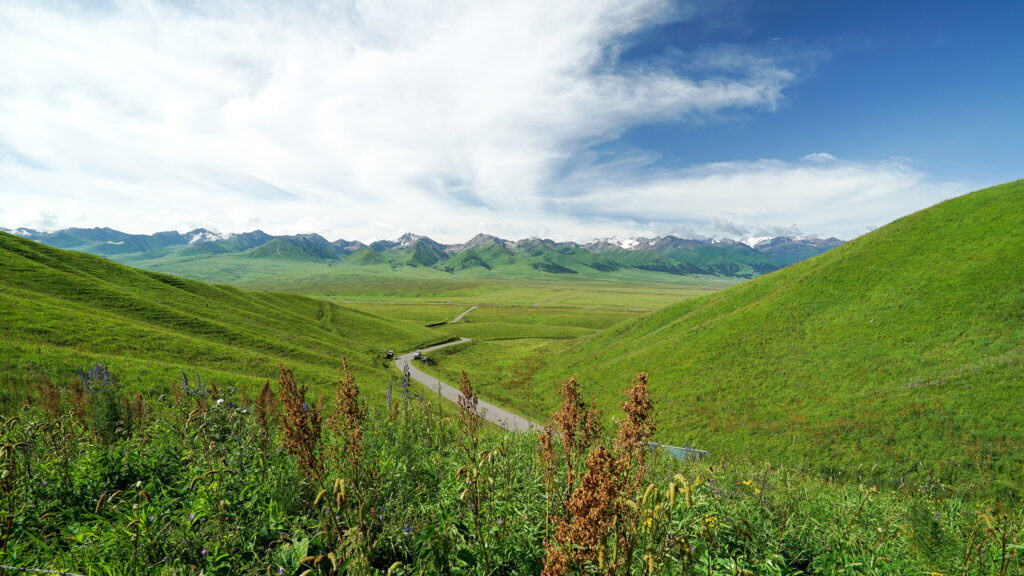
The name of these grasslands was given by one of the troops of the warrior Genghis Khan, who, impressed by the colour of the meadows, called them Nalati, which in Mongolian means “place where the sun rises”. In this grassland, still witness to Kazak practices and customs, as well as traditional sports, falcons are bred for hunting with inhabitants residing in yurts. The best season to visit the grasslands is between May and October.
The Best Places in South Central China (Zhongnan)
27. Yulong River, Guangxi Zhuang
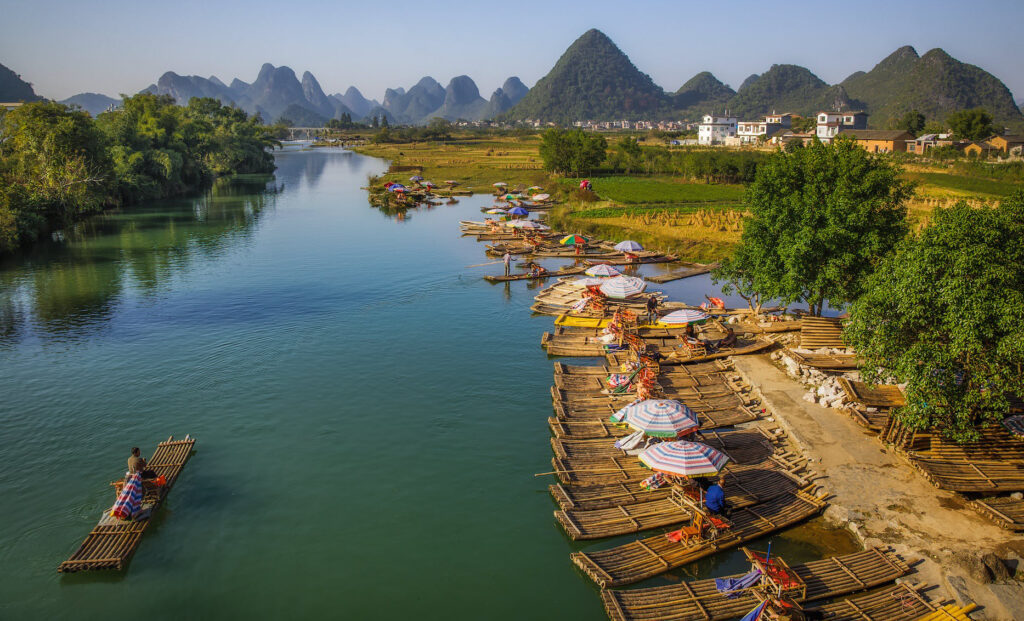
The Yulong River is mainly placid, and the scenery along it is stunning. Simple farms can be seen on the wild and rugged landscape, where water oxen roam freely. It is also a fun place for rafting. The Yangshuo area is very beautiful, and outside the city you can walk or cycle among the farmers’ roads, and explore the area. The best time to visit the Yulong River is from April to October, when the weather is mostly sunny, warm and suitable for outdoor activities.
28. Li River, Guilin
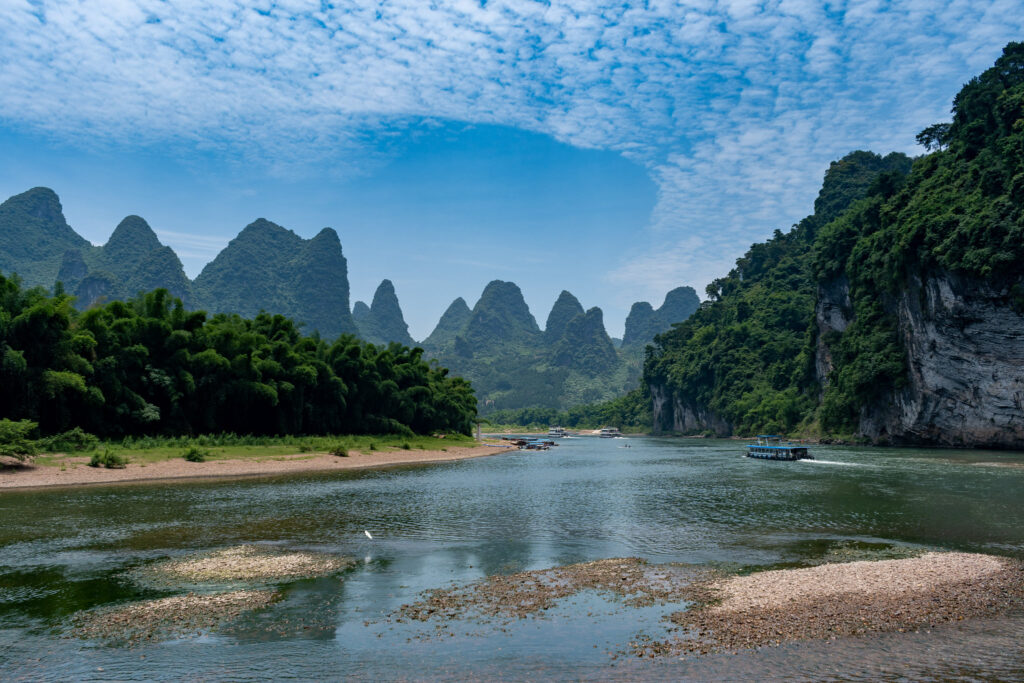
The Li River is a tributary of the People’s Republic of China that flows through the autonomous region of Guangxi. The 83 km channel offers one of the most spectacular landscapes of this Asian territory with mysterious caves, impressive mountains, vertiginous cliffs and bamboo forests that reach the banks of the river. It is one of the most popular tourist destinations in China, attracting thousands of people every year.
29. Guanyin Statue, Hainan
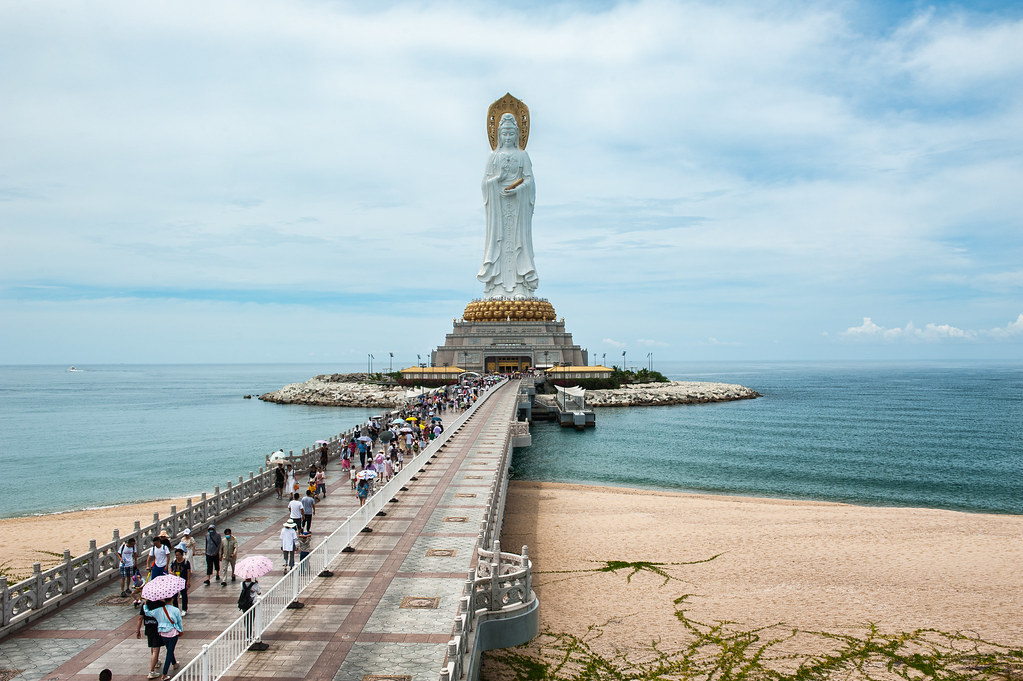
At 108 metres high, the Guanyin statue is the fourth largest statue in China; one of its tourist sites in the Nanshan cultural district in Hainan, 40 kilometres away from the centre of the town of Sanya. The “Buddhist goddess of mercy” has three sides facing, one to mainland China, Taiwan and the South China Sea. The image was blessed in 2005 and is also considered one of the tallest statues on earth.
30. Yalong Bay, Hainan
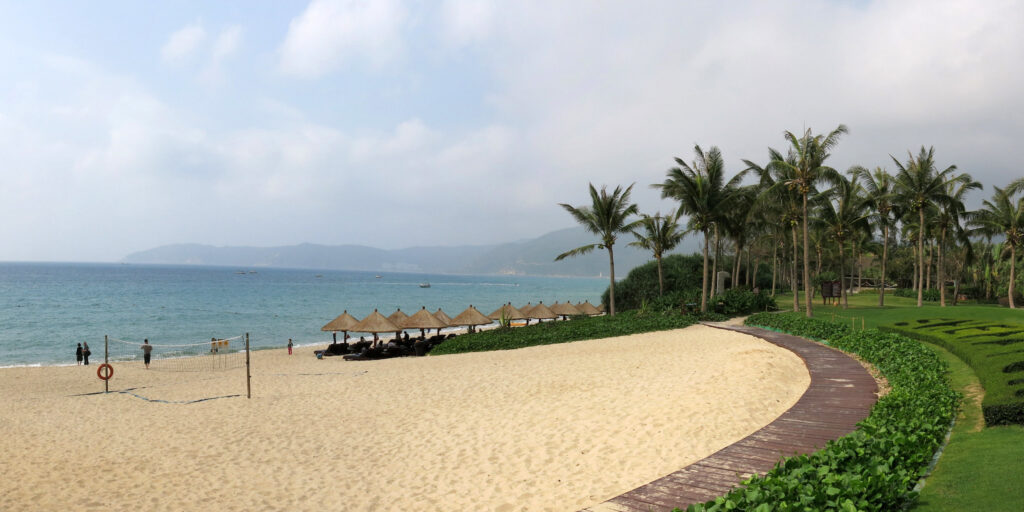
Yalong Bay unfolds in a 7.5-kilometer circular arc at the southern tip of the island. It is a tropical paradise: white sand, turquoise waters and blue sky. Several large hotel chains have settled here. Tourists resting on these beaches can also practise water sports or scuba diving. If you are a lover of these water sports, I recommend you to go to the equipment rental shops, where you can also receive instruction and even join groups to discover the bottom of the sea.
31. Longmen Grottoes, Henan
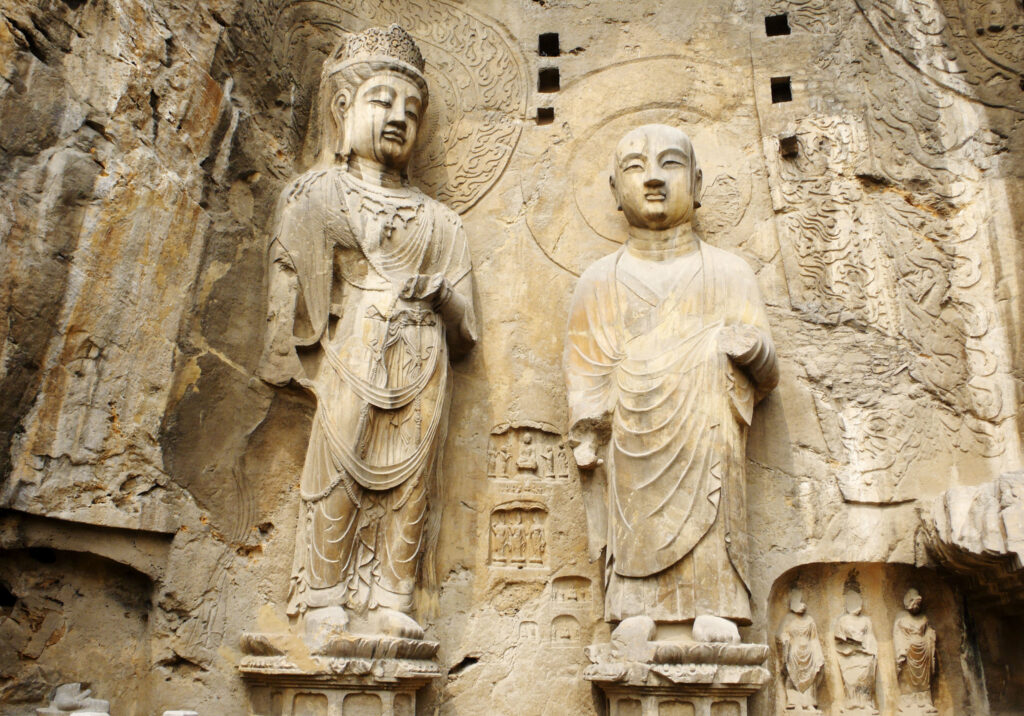
The Longmen Grottoes are one of the best examples of Chinese Buddhist sculpture, preserving tens of thousands of sculptures of Buddha and Bodhisattvas. They are an essential visit both within the province of Henan and China in general. Various acts of vandalism over the centuries have caused many of the statues to be decapitated, one-armed or have been directly torn off in its entirety to be sold to private collections or exhibited in museums around the world. Even so, this does not detract from the beauty of the place.
32. Shennongjia, Hubei
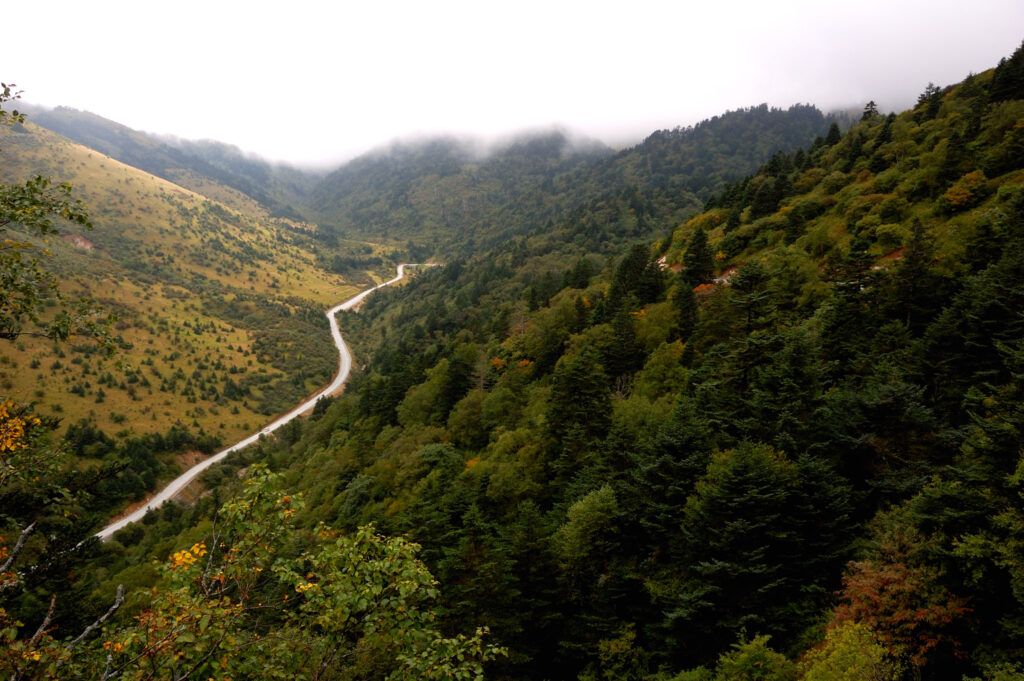
It is the site of the Daba Mountains and the Qinling Range. Shennongjia covers an area of approximately 3250 square kilometres. According to local statistics, it is home to more than 54 types of animal species: 190 birds, 12 reptiles and 8 amphibians, accounting for 81% of China’s endemism of 33 biological orders. The reserve is also home to 1131 species of plants, from pines to ferns. According to some legends, in this vast territory lives the “yeti”, a creature similar to the “bigfoot”.
33. Fenghuang, Hunan
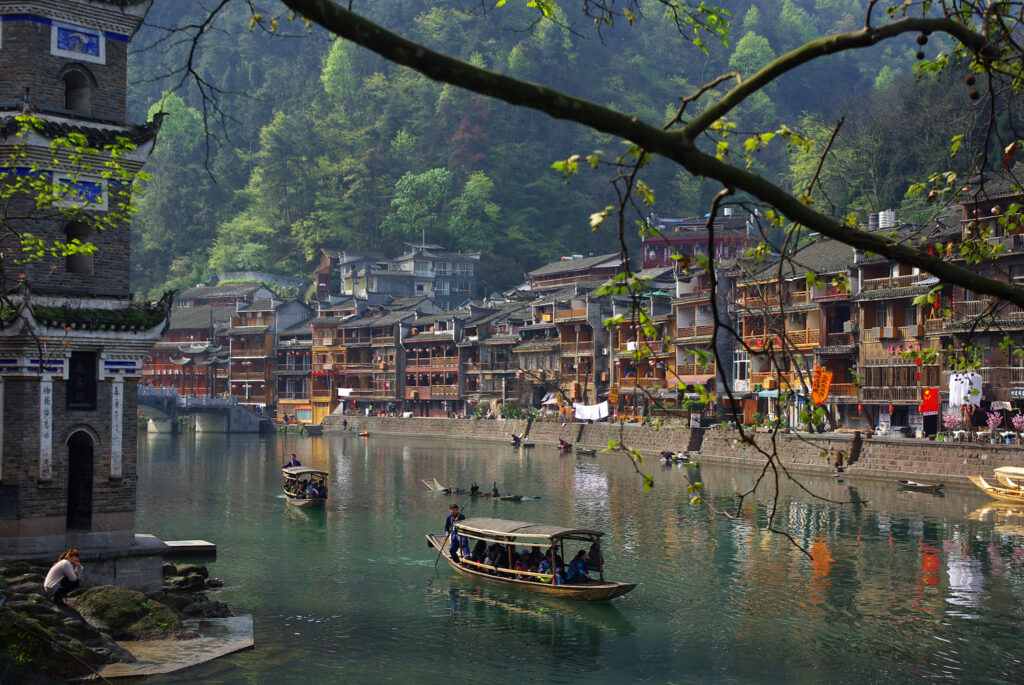
Fenghuang means, phoenix, is a city founded more than 1,300 years ago with 200 residential buildings, 20 streets and 10 alleys, all built during the Ming dynasty. The city, whose houses are raised on stilts, is much visited by followers of art and literature, who go to pay homage to the Chinese writer, She Congwen, author of the “Frontier City”.
34. Longtan Valley, Hunan
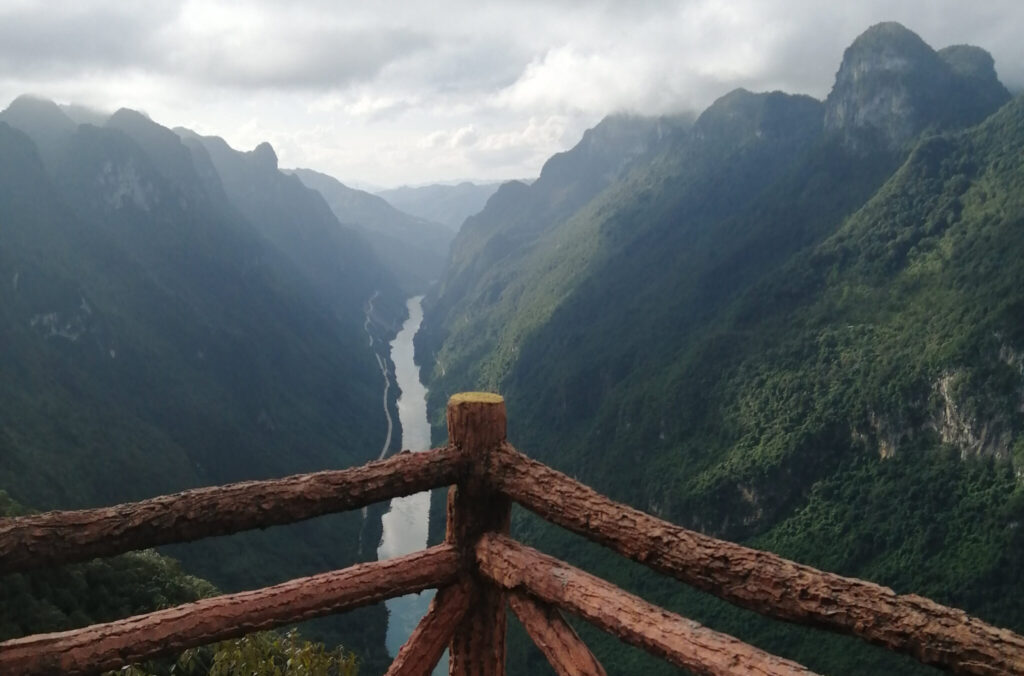
The 12-kilometre Longtan Valley is considered the number one among the narrow gorges in China. It is defined by a strip of purplish-red quartz sandstone. The valley is irregular in shape, with lots of vegetation and large cliffs.
35. Tianmen Mountain, Hunan
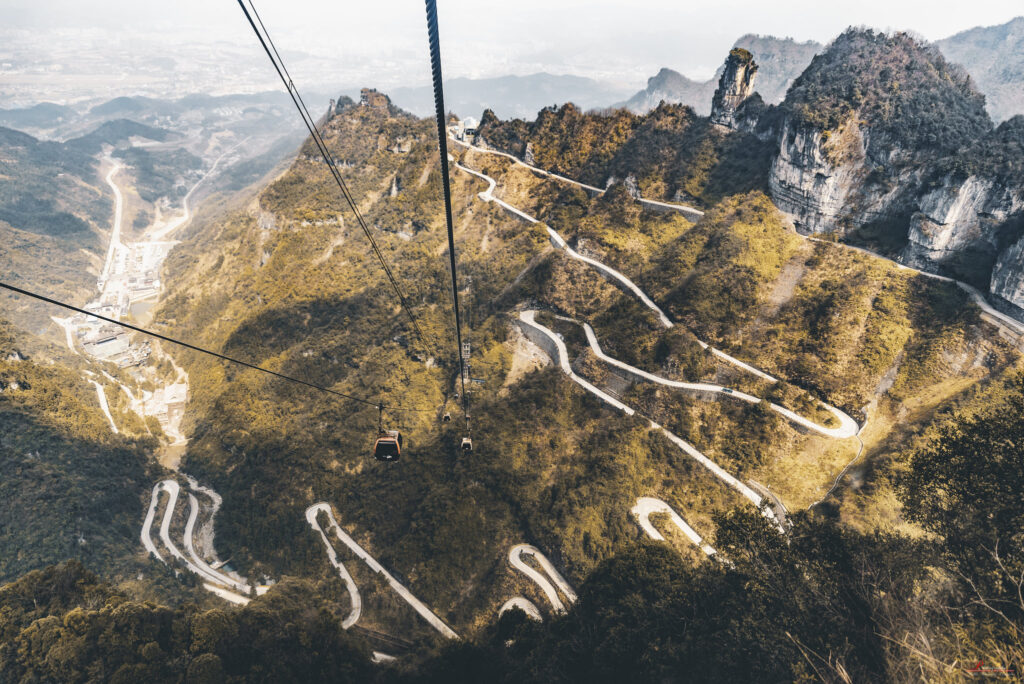
Tianmen Mountain is about 1500 metres above sea level, it is also known as the Gate of Heaven in China, because at the top of the mountain there is a hole created by nature, this cave looks like the door connects to heaven. That as its main attraction, it adds to other tours with spectacular natural scenery that attract a large number of visitors a year throughout the area. One of the most recent attractions includes glass walkways more than 1 kilometre high.
36. Fortress Towers, Kaiping
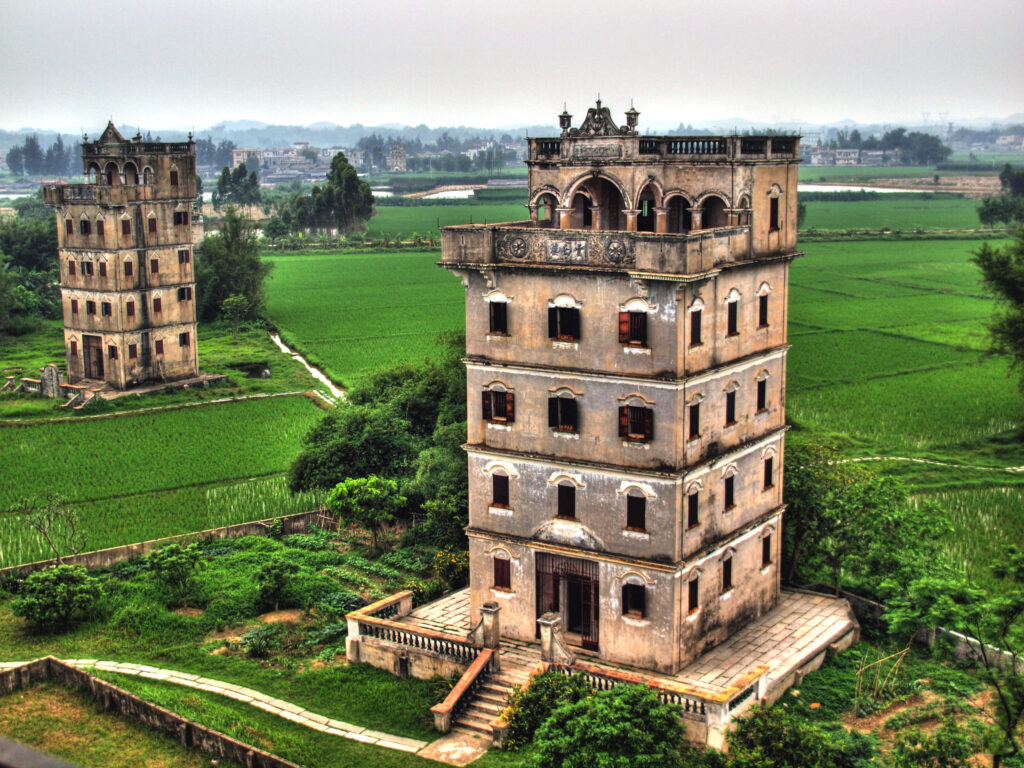
The fortress towers in Kaiping, a city a little more than 100 kilometres southwest of Guangzhou, were erected in the early 20th century to protect the population from robbery and war, and at the same time as a manifestation of opulence. There are a total of 1,800 towers in the middle of the city’s rice fields, which you can visit on a tour of its streets.
37. Longji Rice Terraces, Longsheng
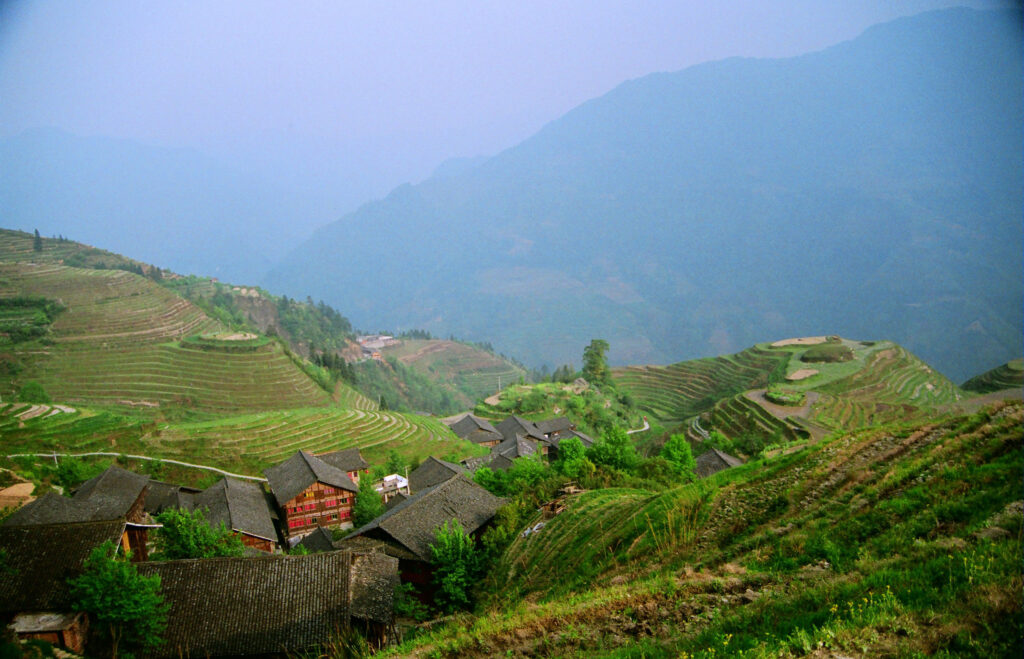
With more than 900 years of history, these terraces were built on the slopes of the mountains in order to make better use of the land and to irrigate the rice fields in an easier and more effective way. Due to the orography of the surrounding mountains, the Longji Rice Terraces are colloquially known as the Dragon’s Back Mountains. The Rice Terraces are much prettier after the rain, as the morning mist is clearing or while the rice is being harvested. If you like to paint or photograph spectacular and beautiful scenery, this would be an excellent destination to practise your art; or come here anyway just to look, admire, and take it all in.
The Best Places in Southwest China (Xinan)
38. Wolong National Park, Chengdu
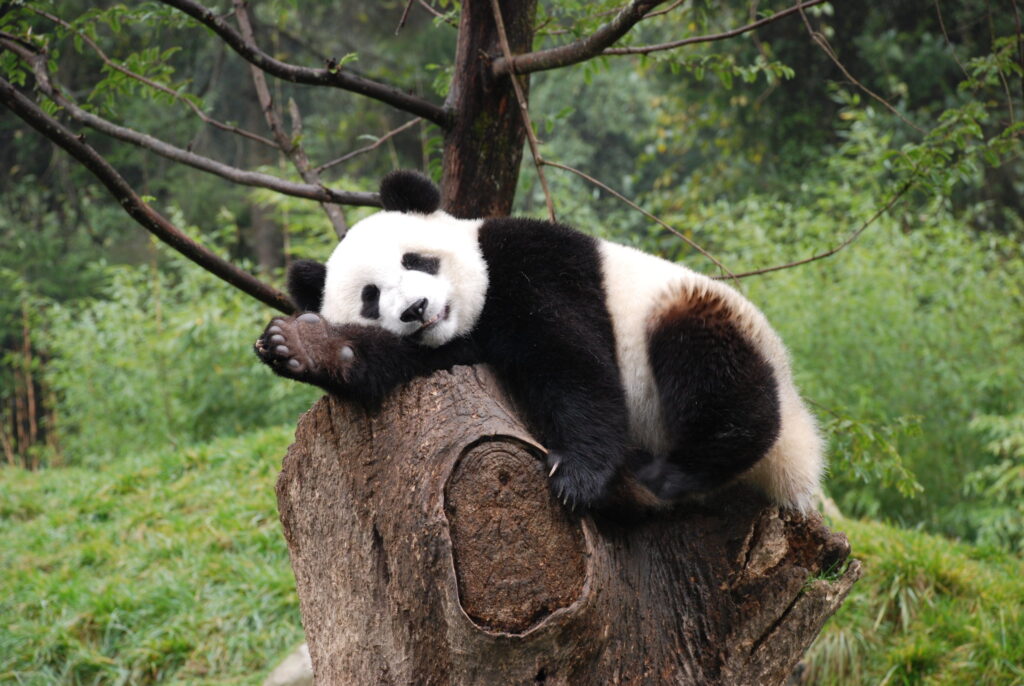
Wolong Nature Reserve, with its 200,000 hectares, is the largest, oldest and best known panda nature reserve in China, currently has more than 150 giant pandas and has made possible the development of 66 panda cubs. In addition to the giant panda, China’s national treasure, the reserve has about 4,000 different endangered species, red pandas, white-nosed deer and a huge variety of plants.
39. Wuhou Temple, Chengdu
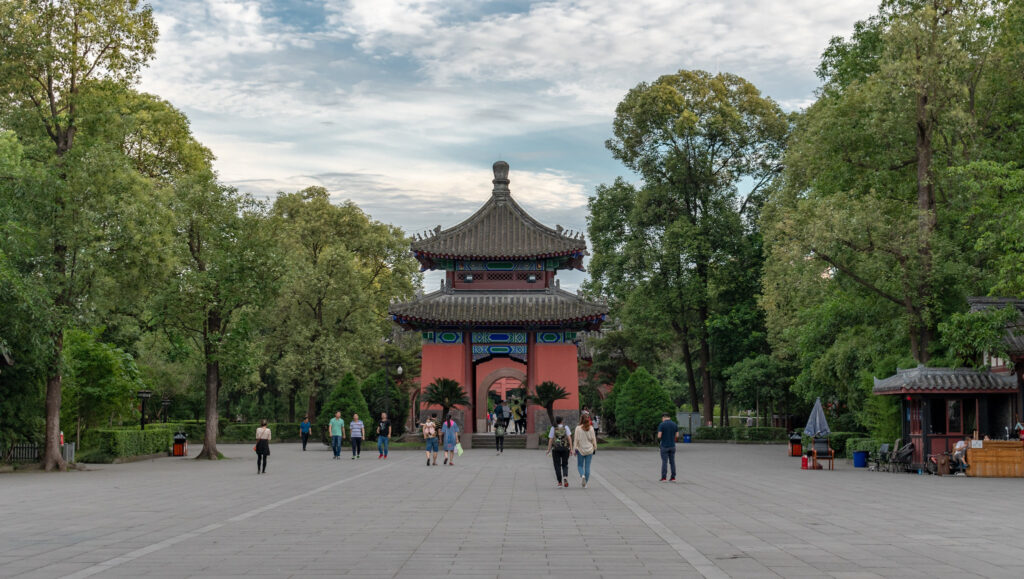
Built in memory of Zhuge Liang around the year 220 under the reign of Shu during the period of the three kingdoms. The Temple of Wuhou, has undergone various renovations and reconstructions over the years due to fires and deterioration, but the initial essence remains intact, being one of the main places of worship in the city. A beautiful hall dedicated to Zhuge Liang awaits us in the Temple of Wuhou, although the most spectacular part of the whole enclosure is the area surrounding the temple. Very similar to a Zen garden, harmony runs throughout Wuhou, with countless trees and plants accompanied by beautiful ponds.
40. Three Pagodas, Dali
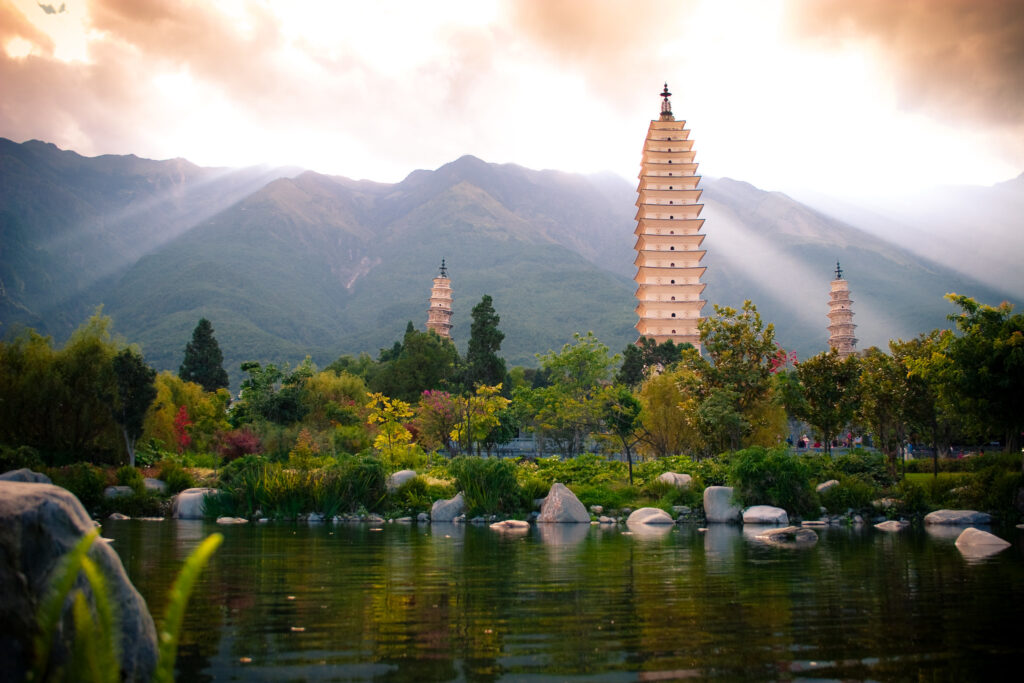
Dali is an ancient town in southwestern Yunnan province, where three Buddhist pagodas were built, the first one erected in the ninth century to pray for the cessation of floods; with its 69 metres high and 16 floors, it could be considered as a “skyscraper” for the Tang dynasty, its builders. It continues to hold the position of the highest pagoda in China, with each of its 16 levels adorned with Buddha statues. The other two towers were built a century later and are each 42 metres high.
41. Huangguoshu Waterfall, Guizhou
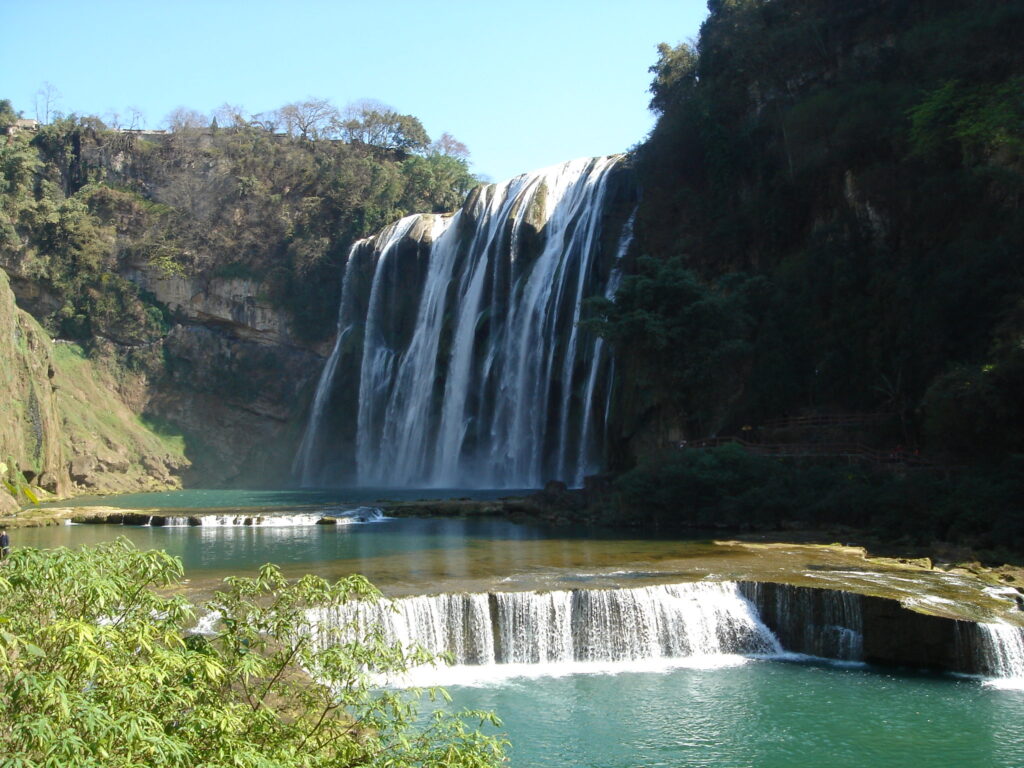
Waterfall of 77.8 metres high and 101 metres long, which makes it the highest in the Asian continent and therefore, one of the tourist sites in China. This natural monument also known as the “Waterfall of the yellow fruit tree” can be visited any month of the year, but the best season for it is June, July and August, when it is seen in all its splendour with an impressive water flow of 700 cubic metres per second. You can access this waterfall from Huangguoshu Airport, 6 kilometres away.
42. Nuorilang Waterfall, Jiuzhaigou
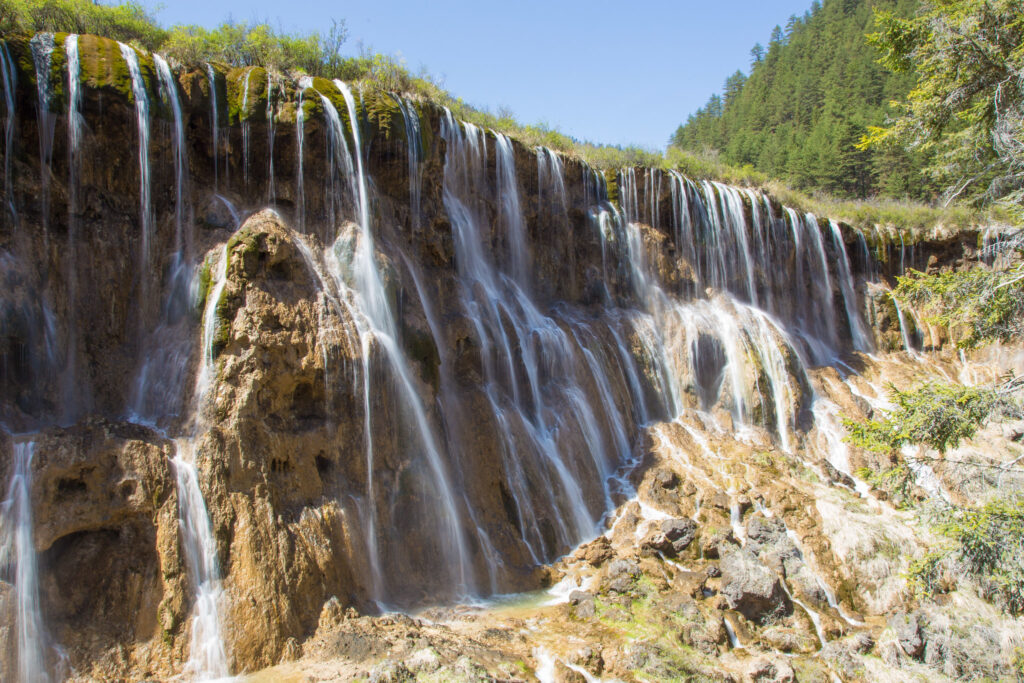
Nuorilang waterfall, as the widest calcified waterfall in China, is about 300 metres wide and 20 metres high. This majestic waterfall can be appreciated from different distances. Flowing down the mountainside in great gusts of foam, you will feel a cooling sensation as the frothy water splashes over your body; seen from the opposite viewing pavilion, it is like a white screen pouring down with a gurgling sound. The waterfall freezes in winter, creating the rare phenomenon of blue ice under the warm sun, making it a must-see stop among Jiuzhai Valley’s many attractions.
43. Bifengxia Panda Base, Sichuan
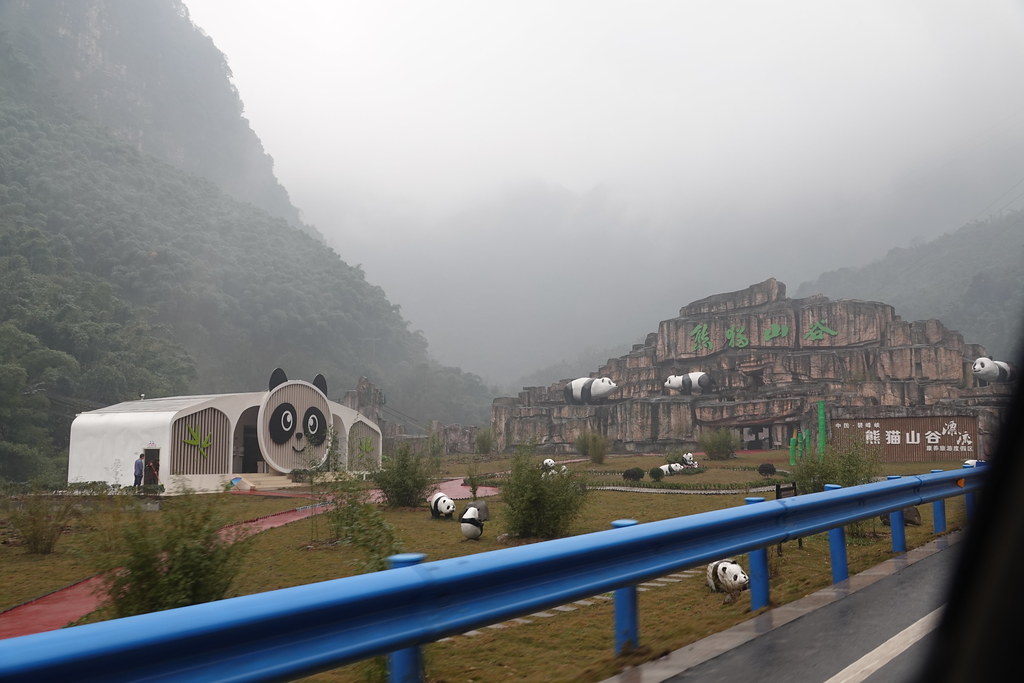
It was opened at the end of 2003, occupies an area of 71.6 hectares and about 60 specimens live in it. It is a highly recommended destination if you are in the province of Sichuan and just want to meet this beautiful animal. You can even participate in the custodian programs there and if you are also fascinated by nature, it is a perfect place to appreciate it since the base of Bifengxia has a wonderful landscape.
44. Chengdu Panda Center, Sichuan
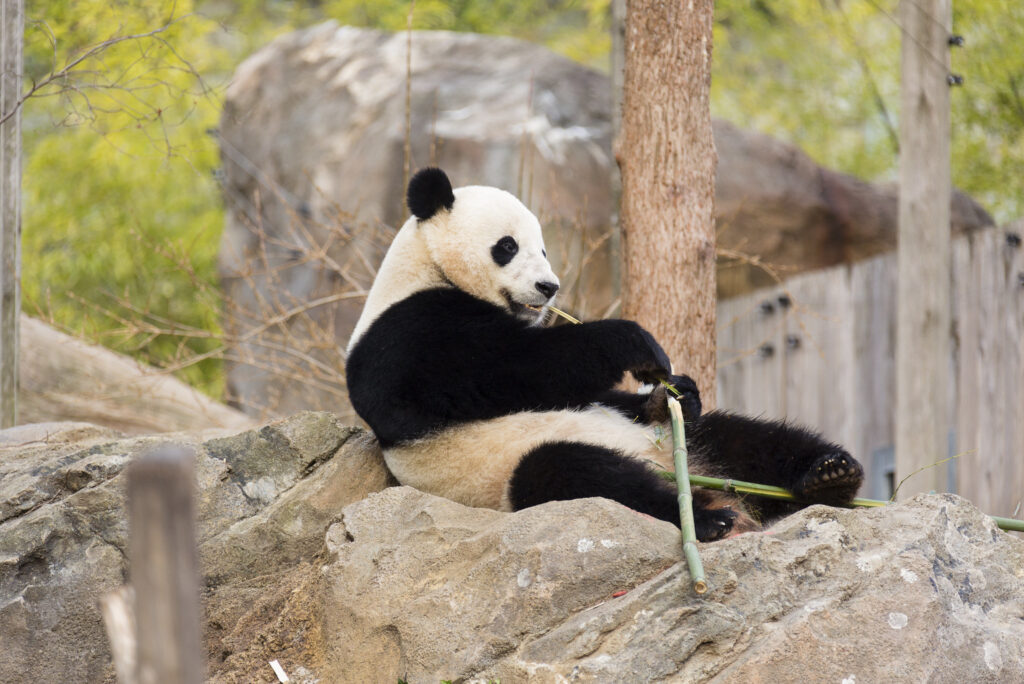
Chengdu Panda Base is the main research base of the Chinese government to carry out the endangered wildlife protection product that mainly concerns the giant panda. It is an absolutely delightful experience for visitors to see them frolicking in their large outdoor enclosures. At present, there are more than 100 giant pandas, and other rare wild animals, such as the red panda, black-necked crane and white crane can also be seen here.
45. Hailuogou Glacier Park, Sichuan
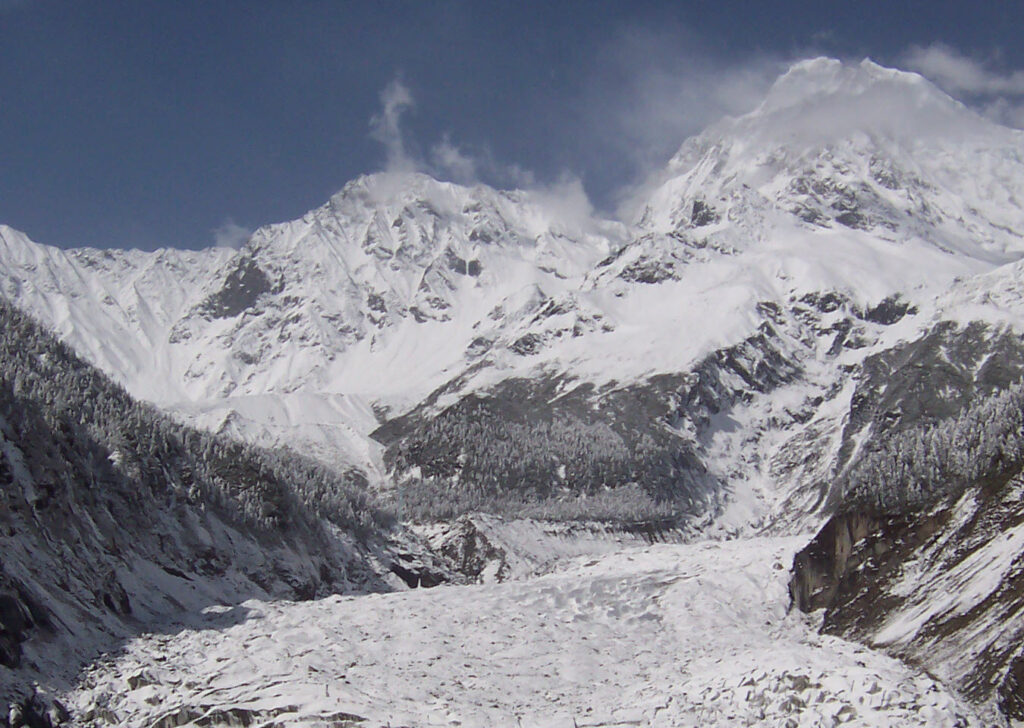
Magnificent park in Sichuan province with a glacier preceded by the legend of a Tibetan monk who transformed this wasteland while playing with his conch shell, attracting animals that began to live there. The park is also known as “Conch Gully”, in honour of the conch and the monk. Although the glacier, which passes through mountains, forests, cliffs, rivers and peaks, can be visited at any time of the year, the best time of the day to observe it is in the mornings. It has more than 10 hot springs flowing below, two of which are open to the public; one is at an altitude of 2,600 metres.
46. Jiuzhaigou National Park, Sichuan
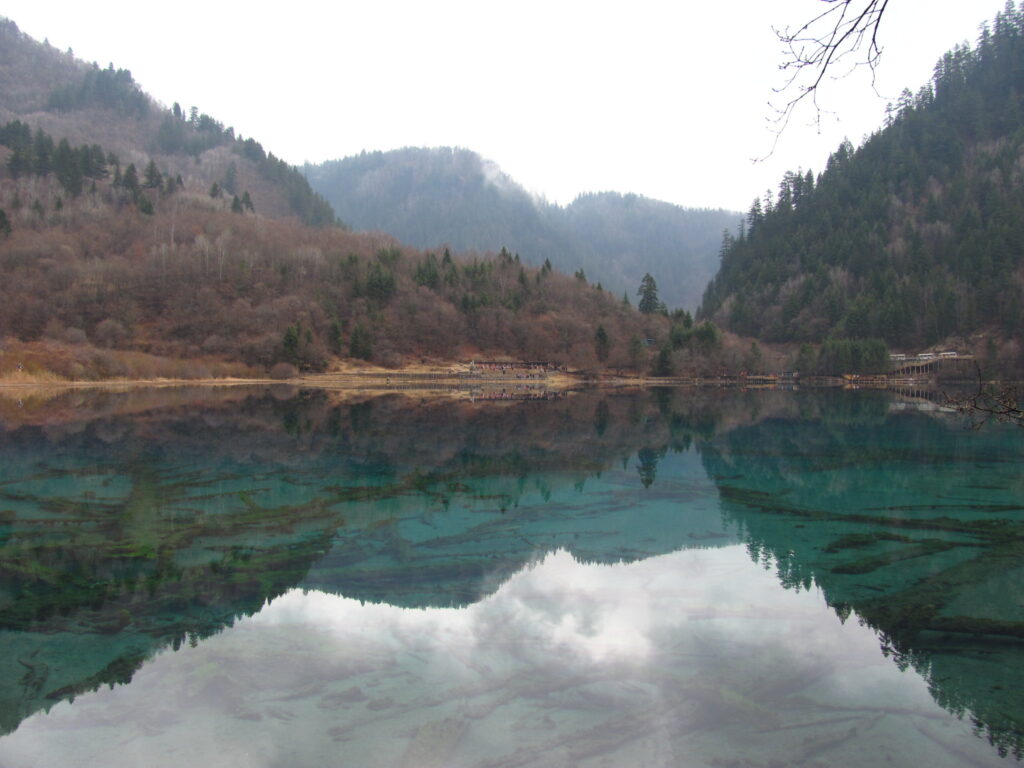
This paradise extends over more than 600 square kilometres. Jiuzhaigou translates as ‘the valley of the nine villages’, a name that refers to the small communities of Tibetan ethnicity that inhabit this territory and that have managed to preserve traditional customs and rhythms that are thousands of years old. Valleys, more than 100 lakes of different turquoise tones, waterfalls and exuberant vegetation are part of this natural reserve. Jiuzhaigou is a wonderful territory rich in colour and life, a masterful work of Mother Nature.
47. Leshan Buddha, Sichuan

It is an immense Buddha statue sculpted in stone between 713 and 1803 AD, declared a World Heritage Site by Unesco in 1993. At 71 metres high, this architectural jewel in all of China is the largest stone Buddha in the world. It is located in the city of Leshan, Sichuan province. It was a work undertaken during the Tang dynasty by the Buddhist monk, Haitong, to pray and give thanks for the end of the natural disasters caused by the Dadu and Ming rivers.
48. Mount Emei, Sichuan
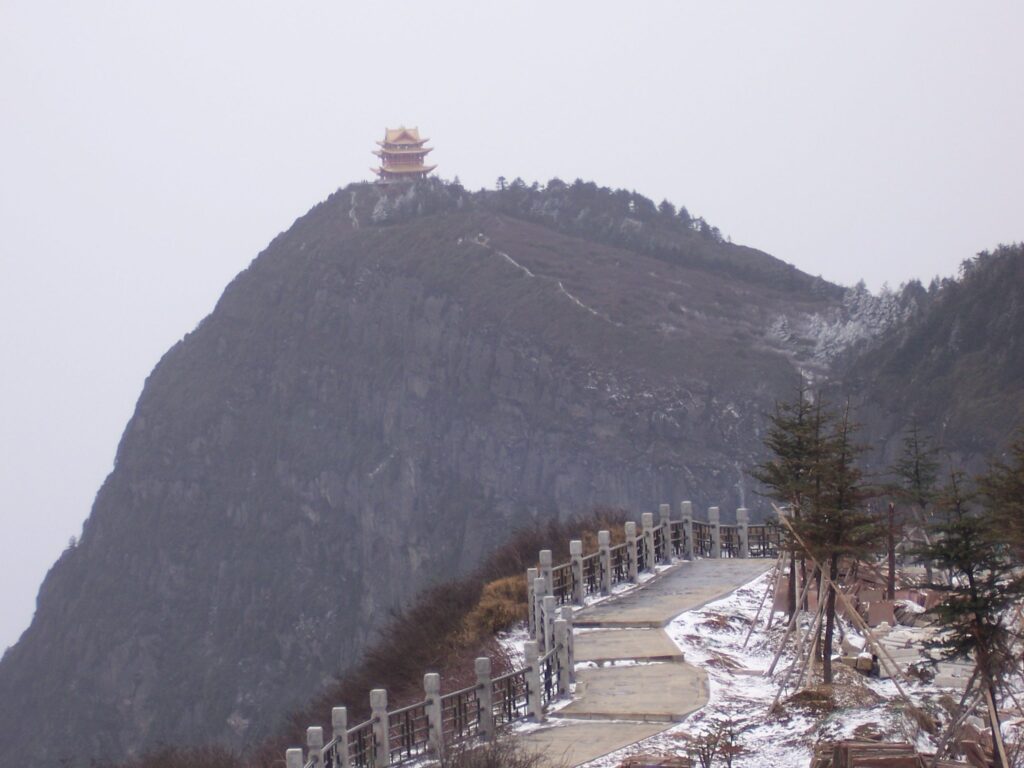
If you like great natural scenery and hiking, Mount Emei can be an interesting stop on your trip to Chengdu. At present, Mount Emei, at just over 3,000 metres high, is the highest of China’s four sacred Buddhist mountains, and is home to 17 Buddhist monasteries. Mount Emei is a great natural scenery that provides great scenery, especially with its seas of clouds, which has become a major tourist attraction with sunsets and sunrises.
49. Jade Dragon Snow Mountain, Yunnan
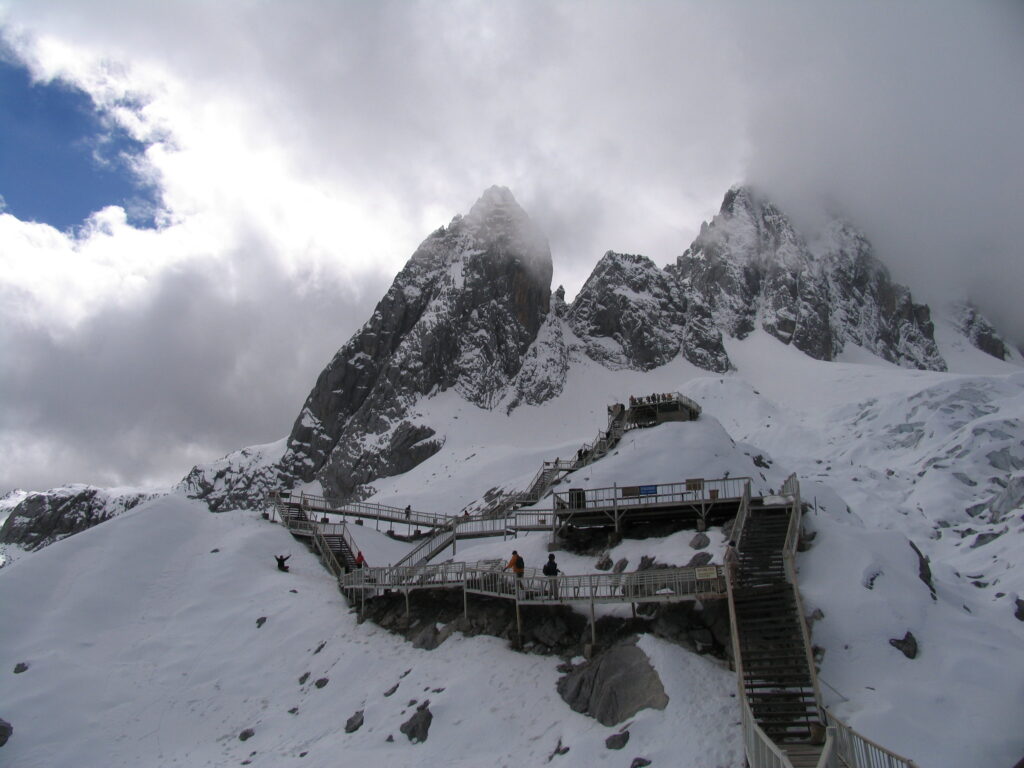
Jade Dragon Snow Mountain is a symbol for the region. Its highest peaks are permanently covered with a mysterious mist, which according to the ancient locals, gives it the appearance of a jade dragon. Hence its name. Jade Dragon Snow Mountain has gradually become a major tourist spot in the region where you can go for a bit of mountaineering, nature exploration, hiking to see the incredible natural scenery it offers, skiing and even scientific research.
50. Lugu Lake, Yunnan
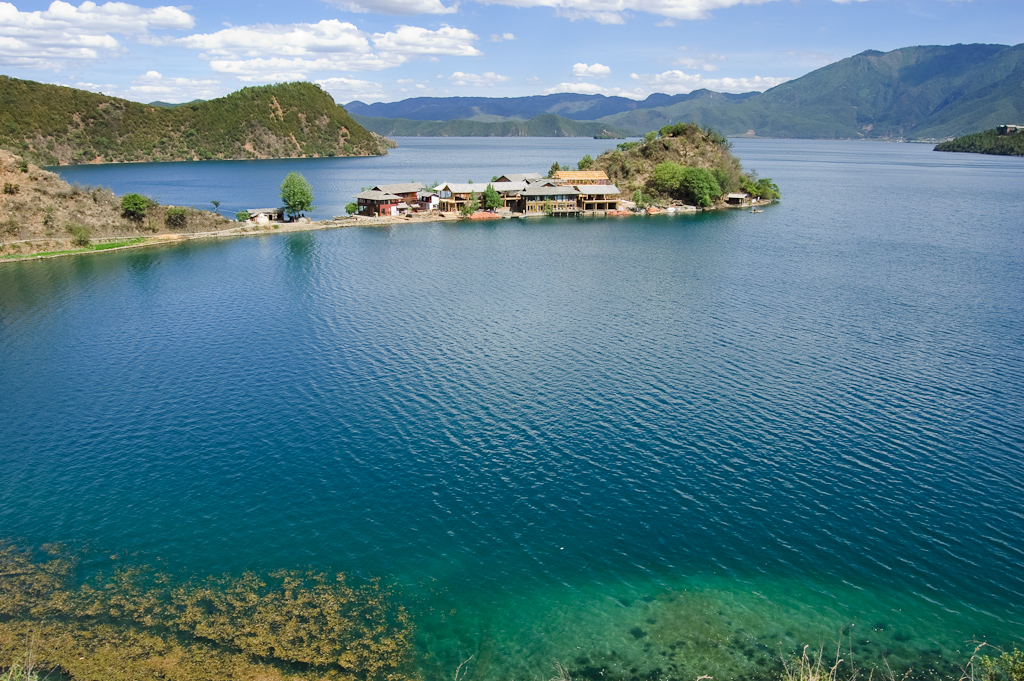
Lugu Lake offers visitors the chance not only to travel through its deep waters and enjoy the scenery, but also to meet one of the country’s most unique ethnic groups. Lugu Lake is home to the Mosuo, a local ethnic group ruled by women. The region in which this crystal clear freshwater lake is located, embraced by imposing mountains and forests, is home to one of the most charismatic and well-known animals in the Asian country: the giant panda bear. Lugu Lake also offers us different leisure options: we can take a dip in its waters, go canoeing or take a walk along its shore.
51. Pudacuo National Park, Yunnan
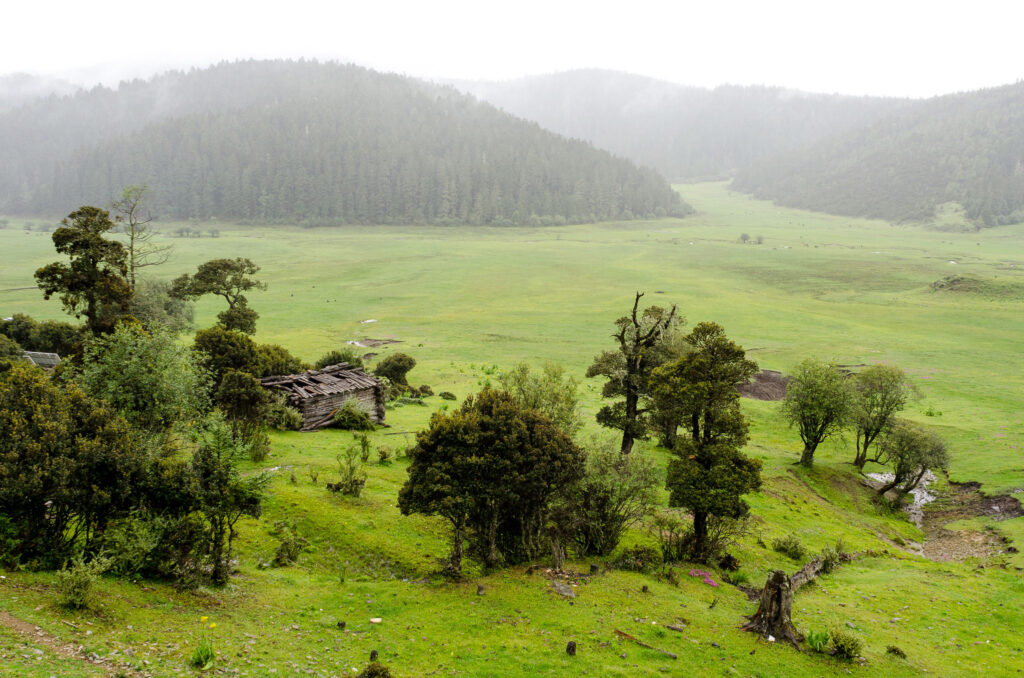
This natural area of black-necked cranes and magnificent orchids complies with the guidelines of “The World Conservation Union”, a relevant global organisation for environmental conservation. About 20% of China’s plant and tree species, as well as a significant percentage of the country’s animals and birds, are found in the wetlands that make up Pudacuo National Park, located in Yunnan Province.
52. Tiger Leaping Gorge, Yunnan
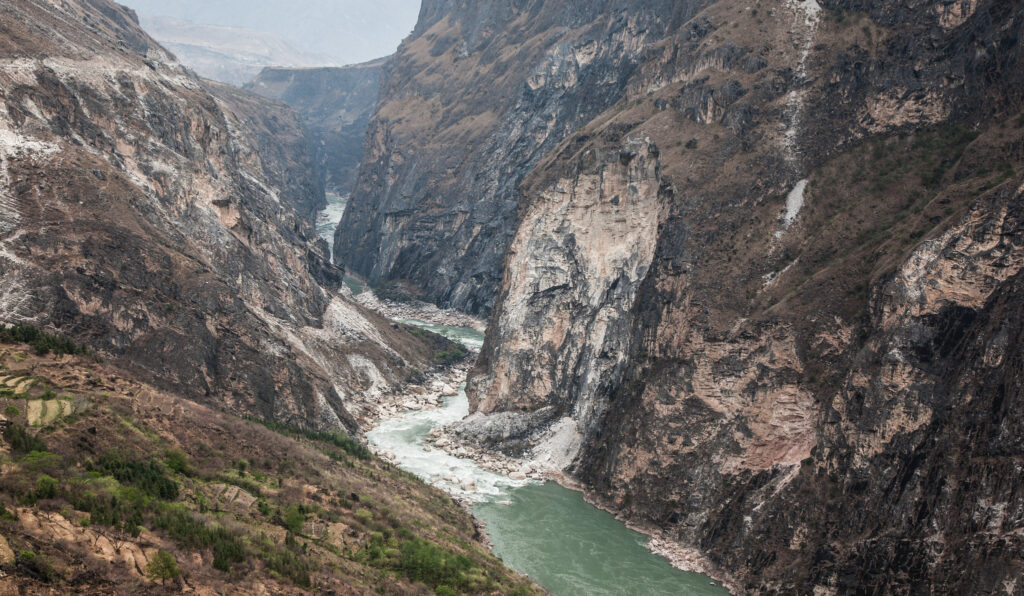
A chain of mountain gorges north of the city of Lijiang, in the province of Yunnan, a place where you can practise trekking and other adventure sports. Its name comes from the legend of a tiger that jumped over the longest point of the canyon to escape from a hunter. There you will find a route that can be travelled from the city of Quiaotou to the region of Daju.
If you loved this article or found it useful, don’t forget to visit and subscribe to my social media for more useful content. Follow us on Google My Business, YouTube, Instagram, Pinterest, Twitter, Facebook or Reddit and subscribe to our receive our free website content.

